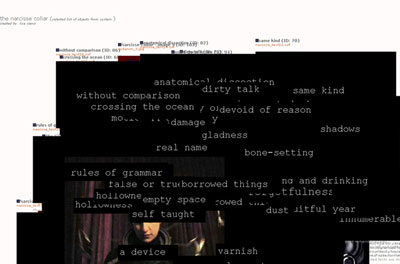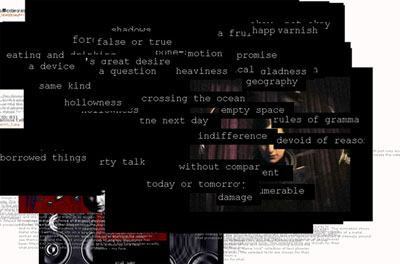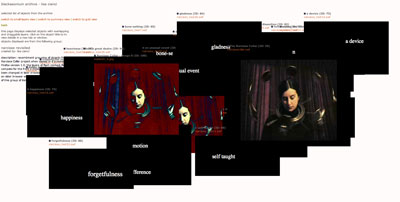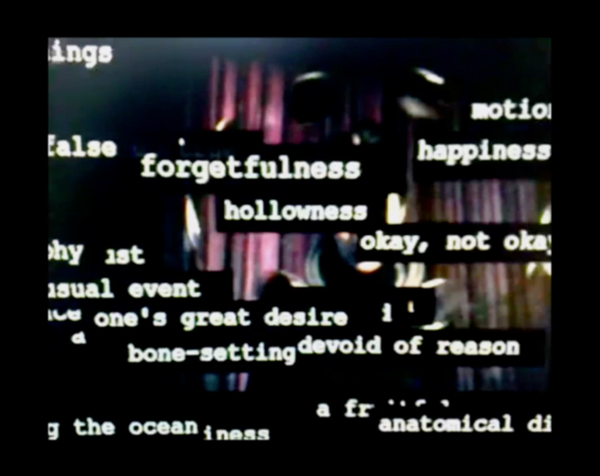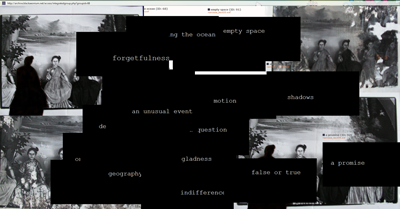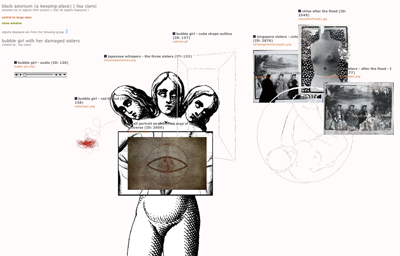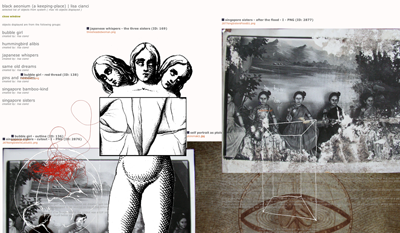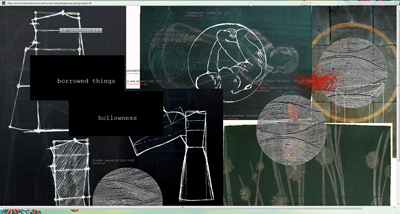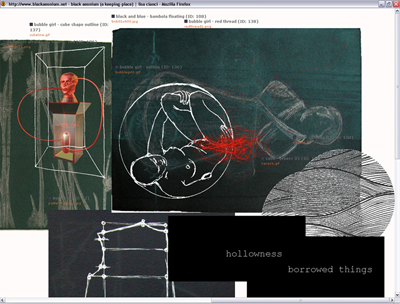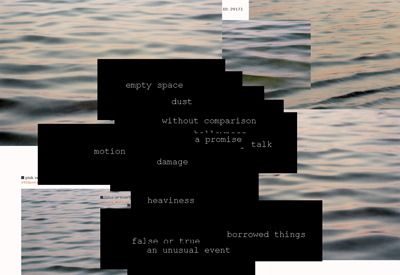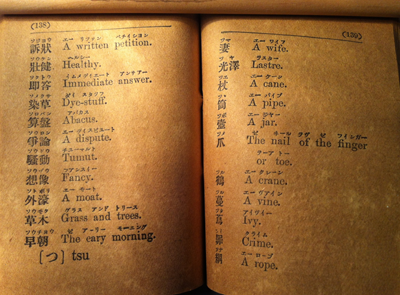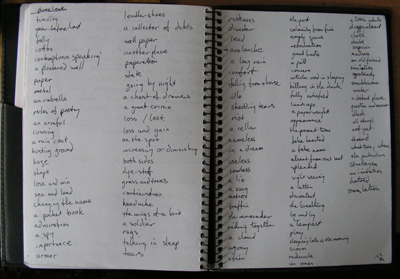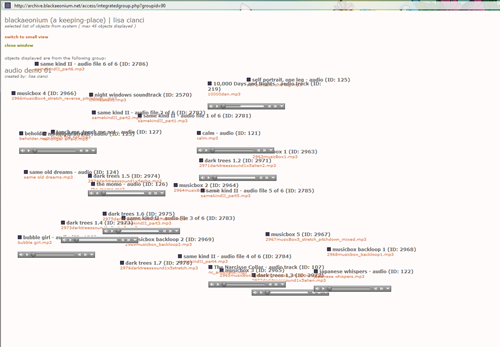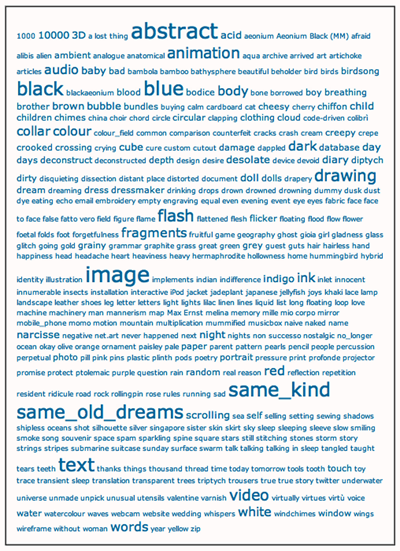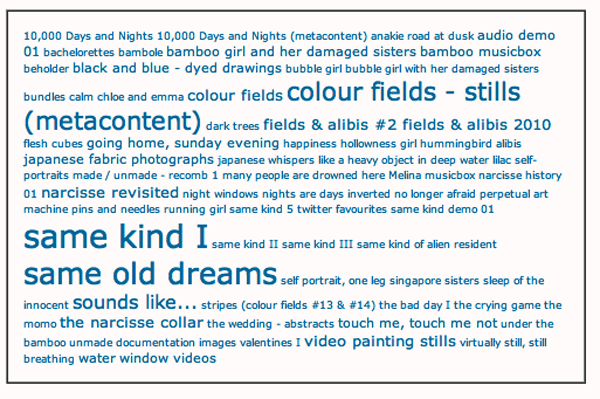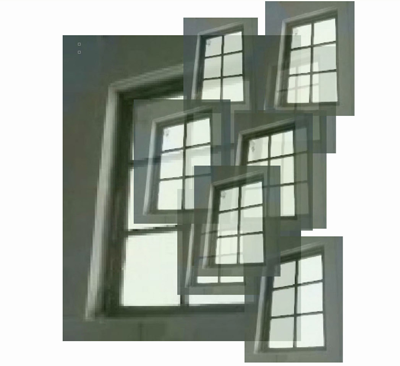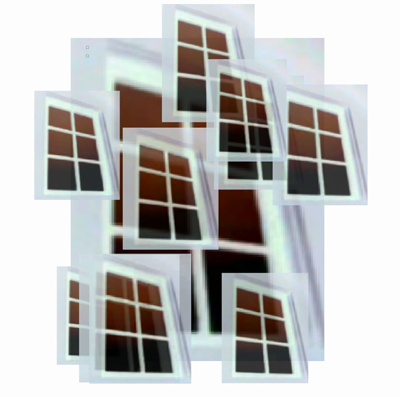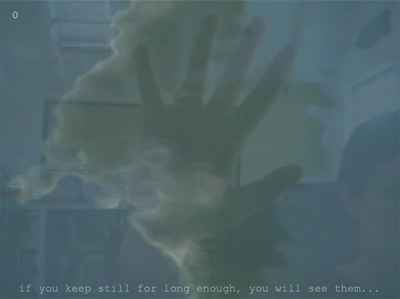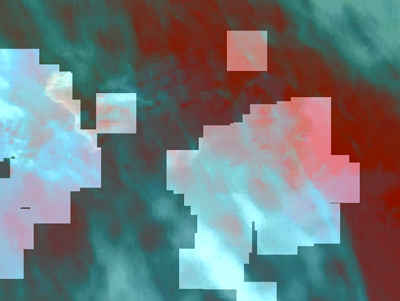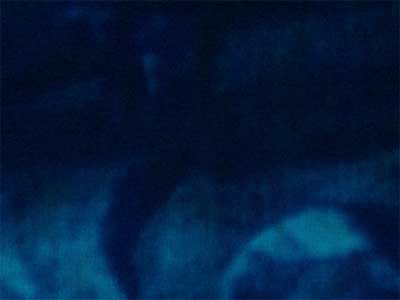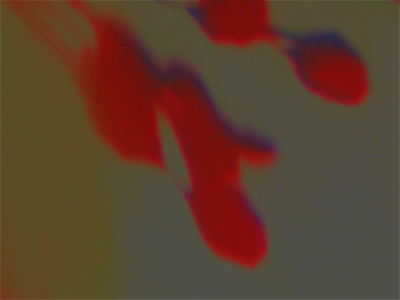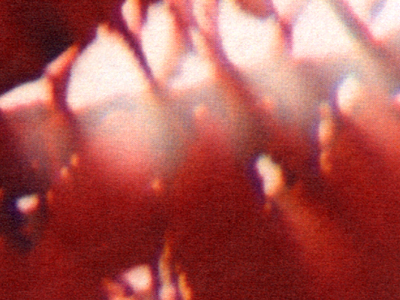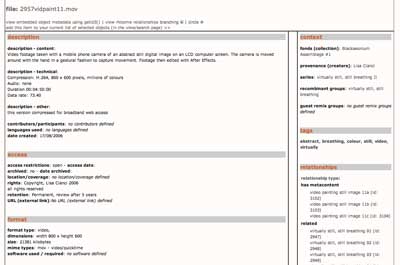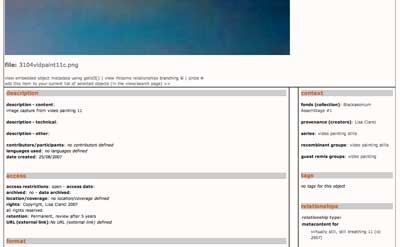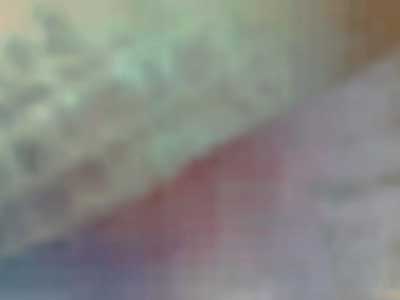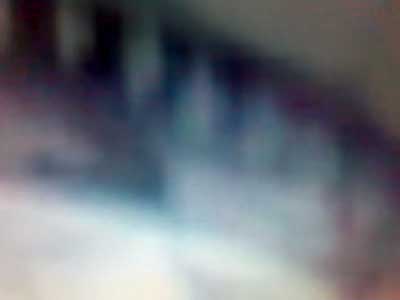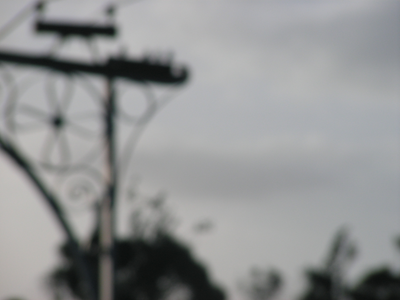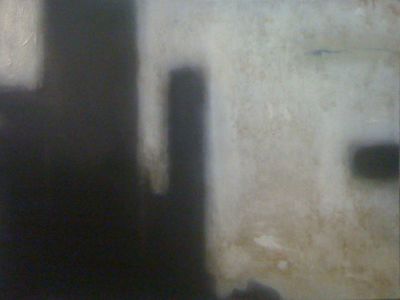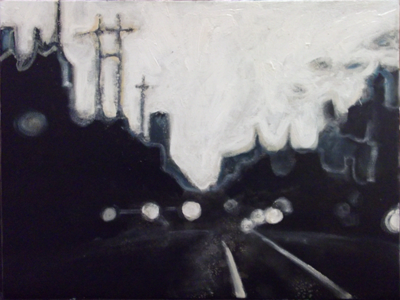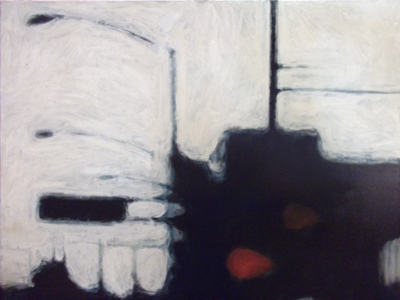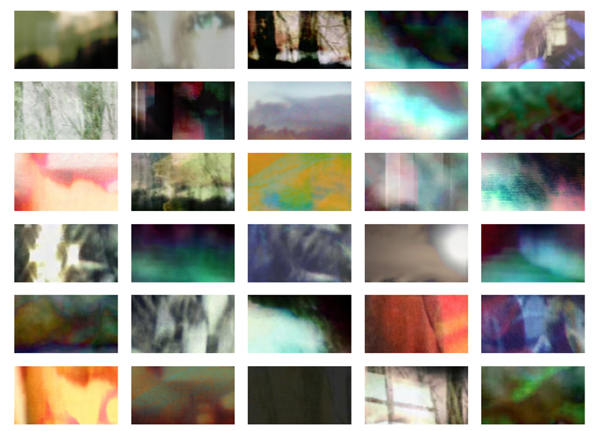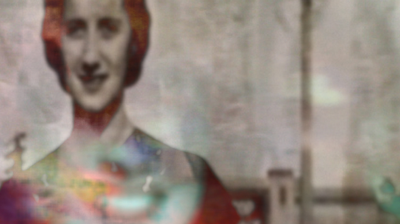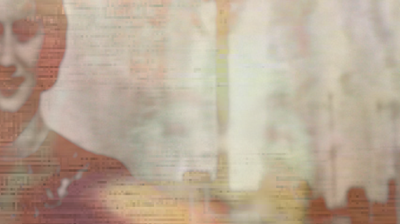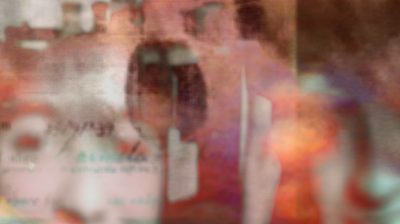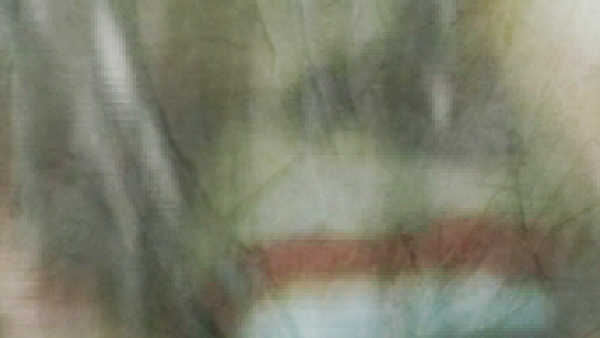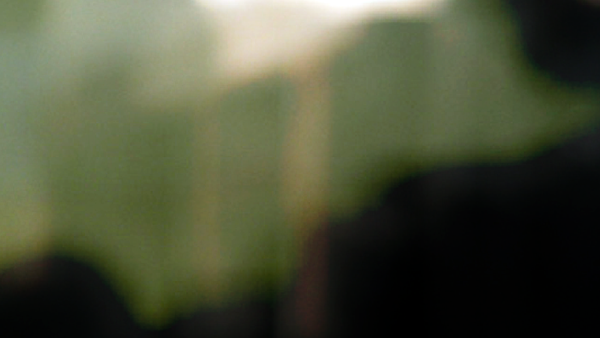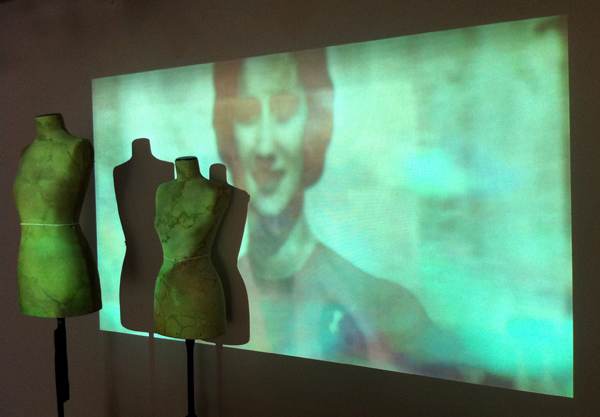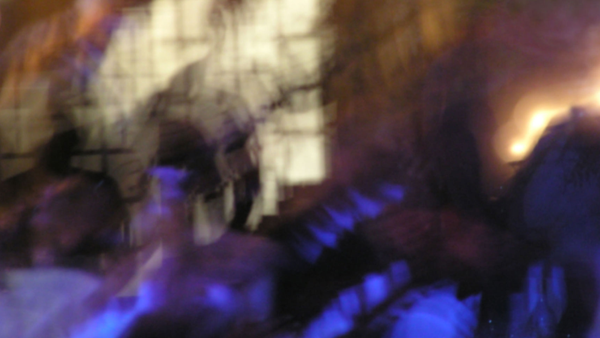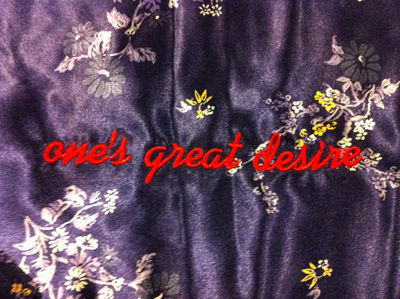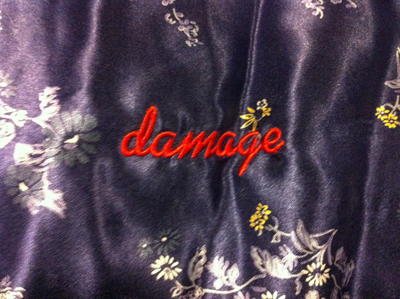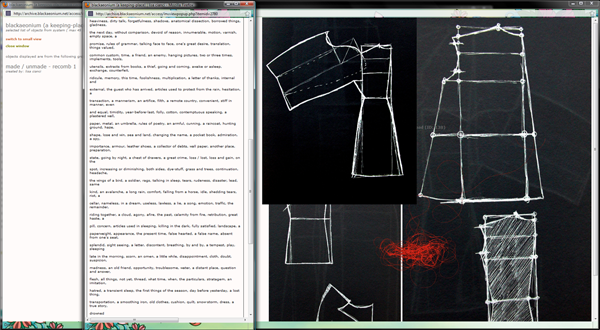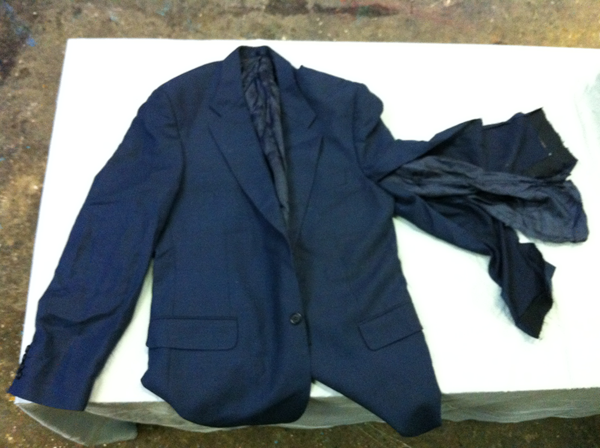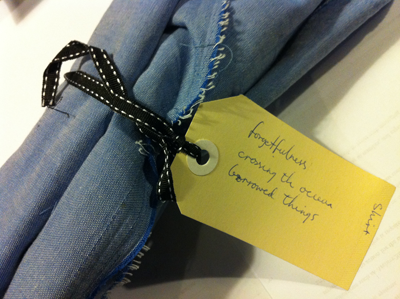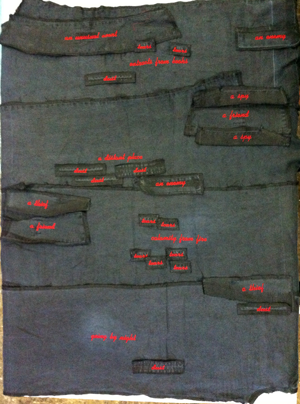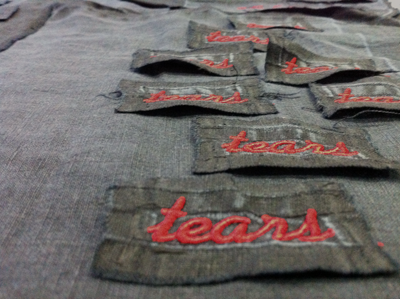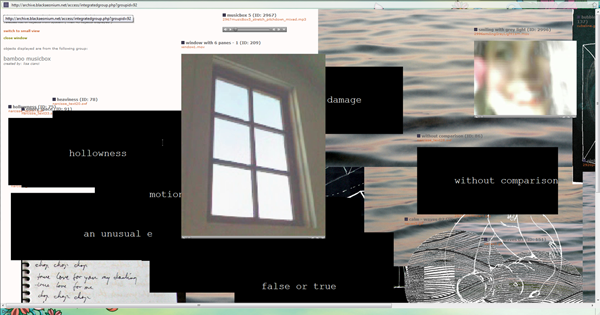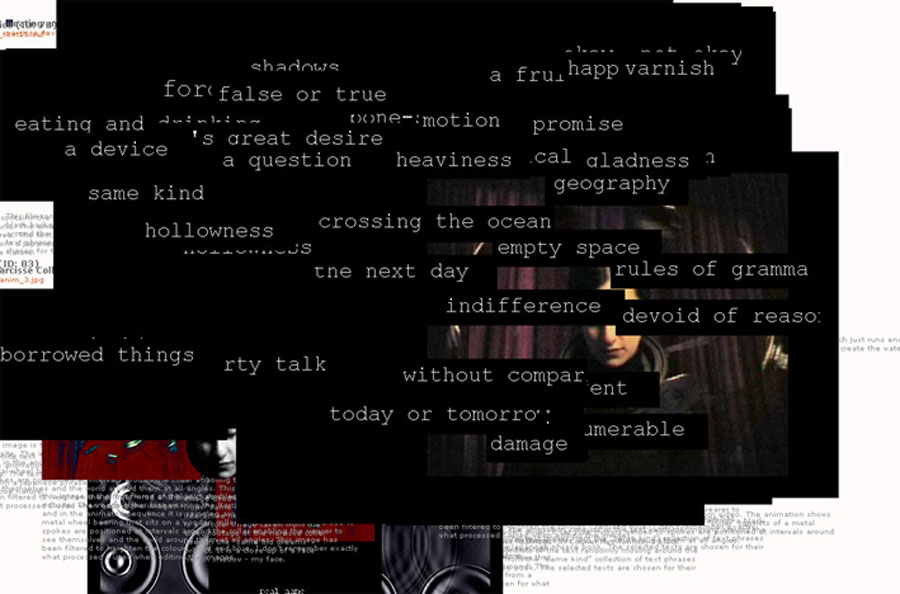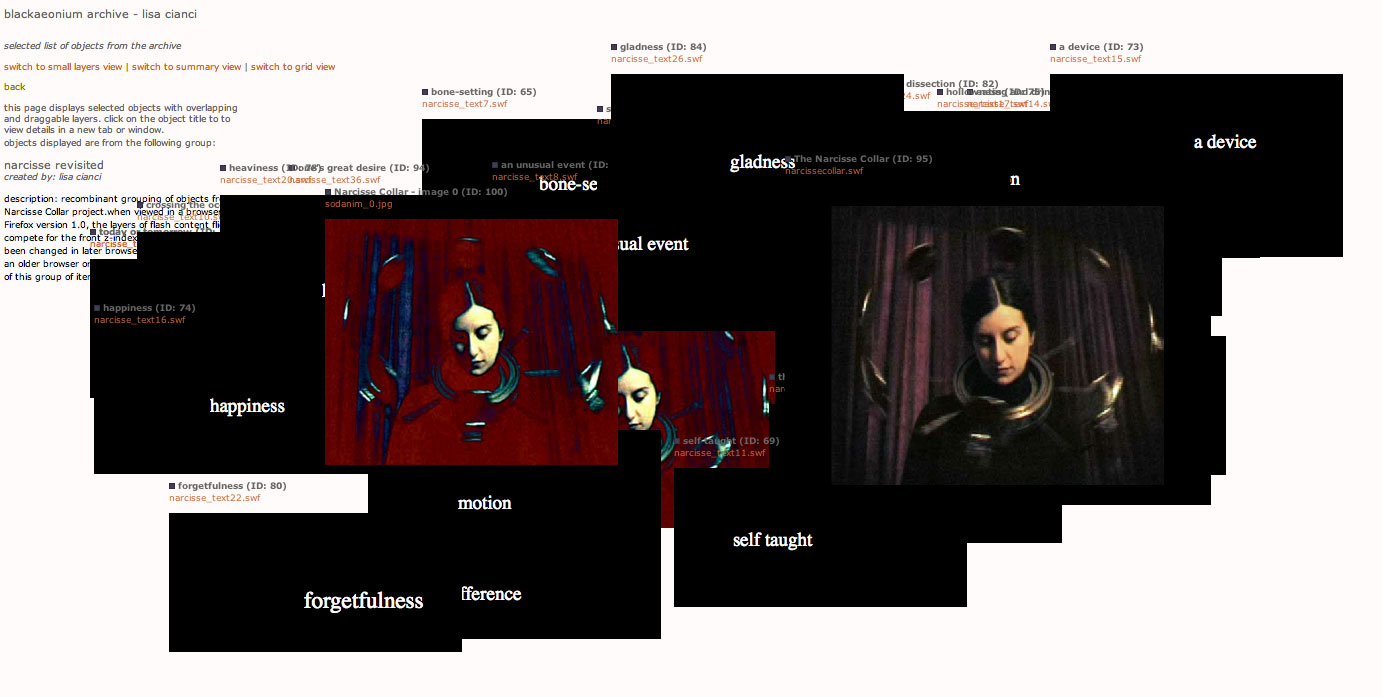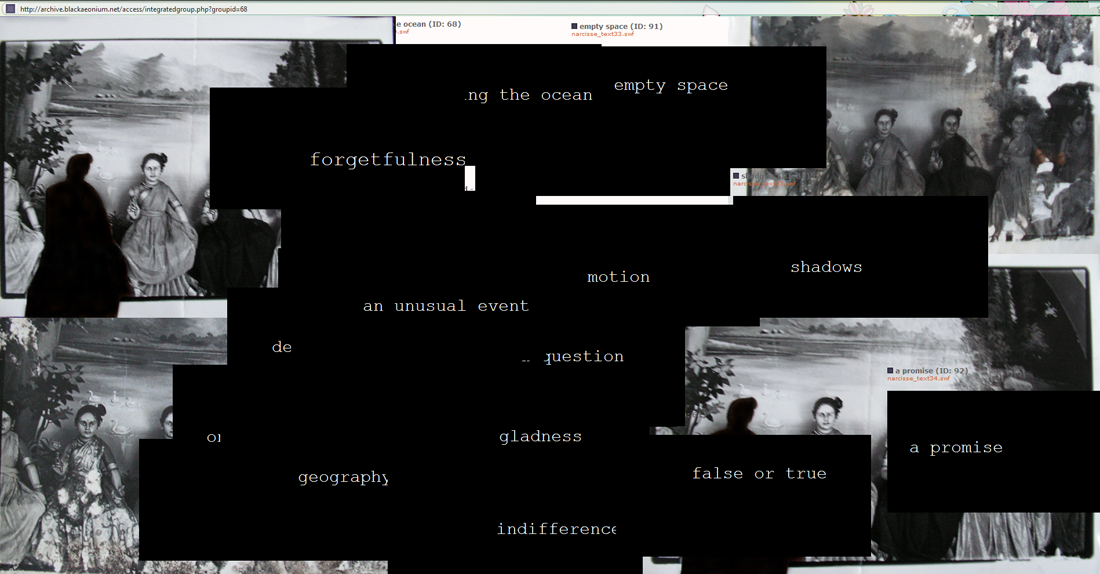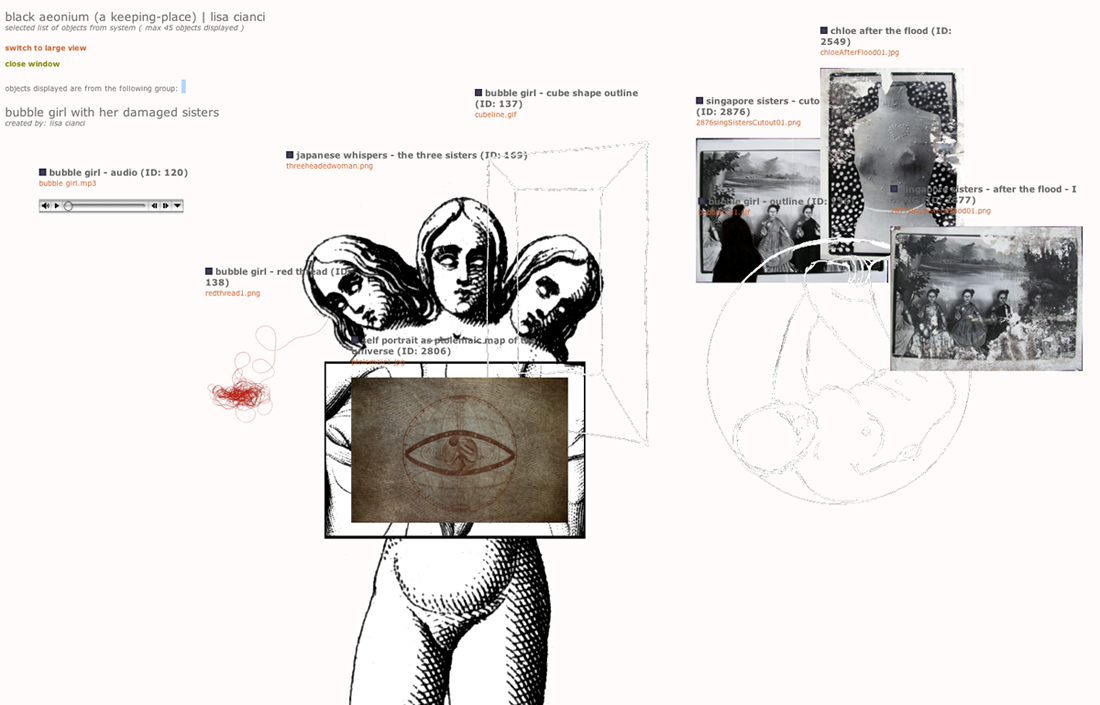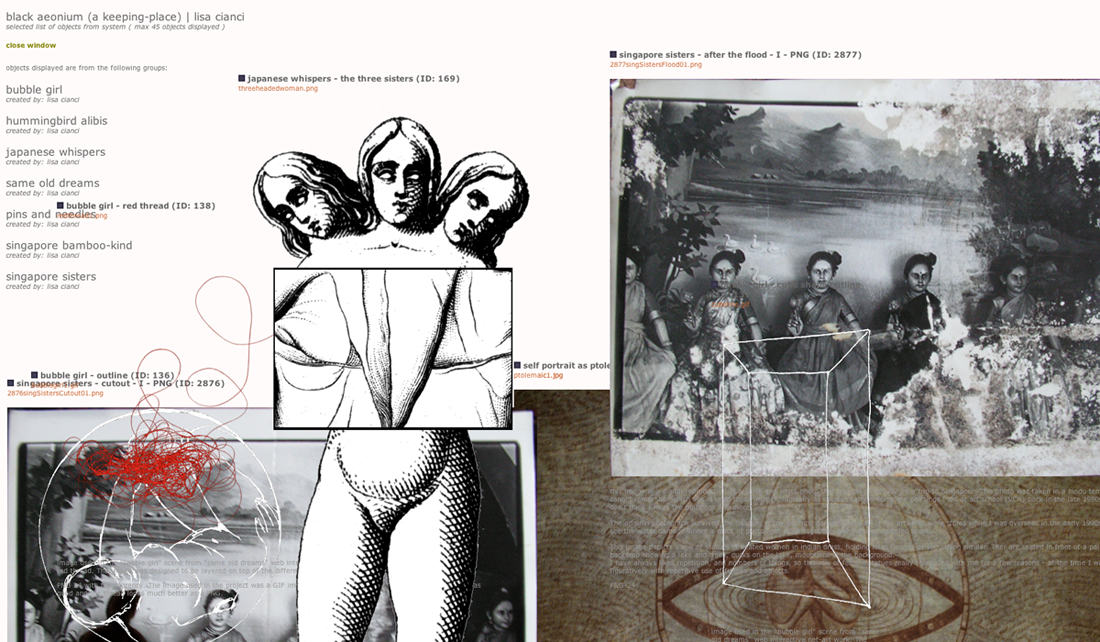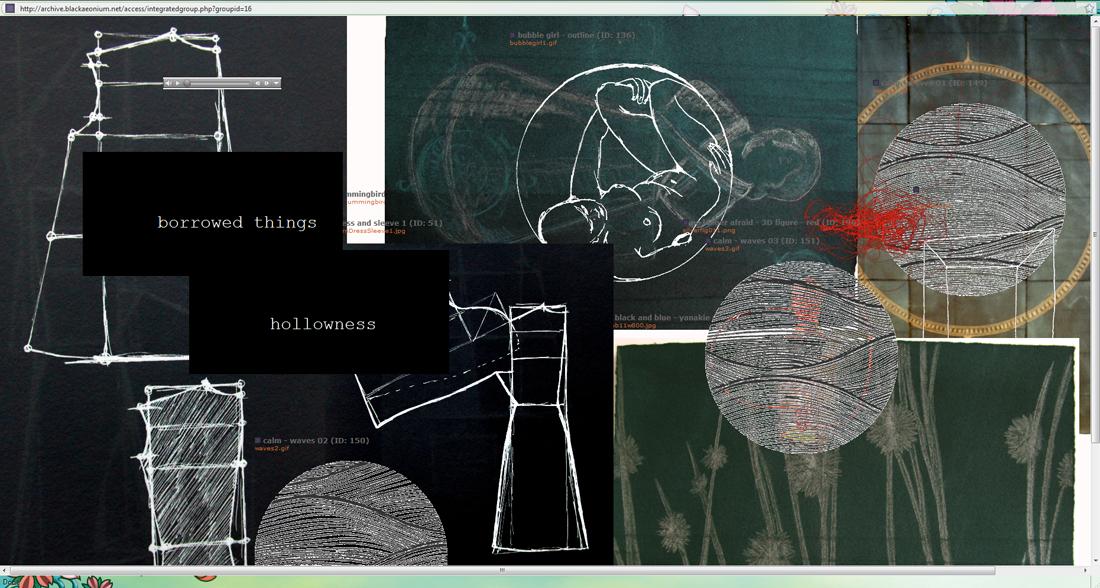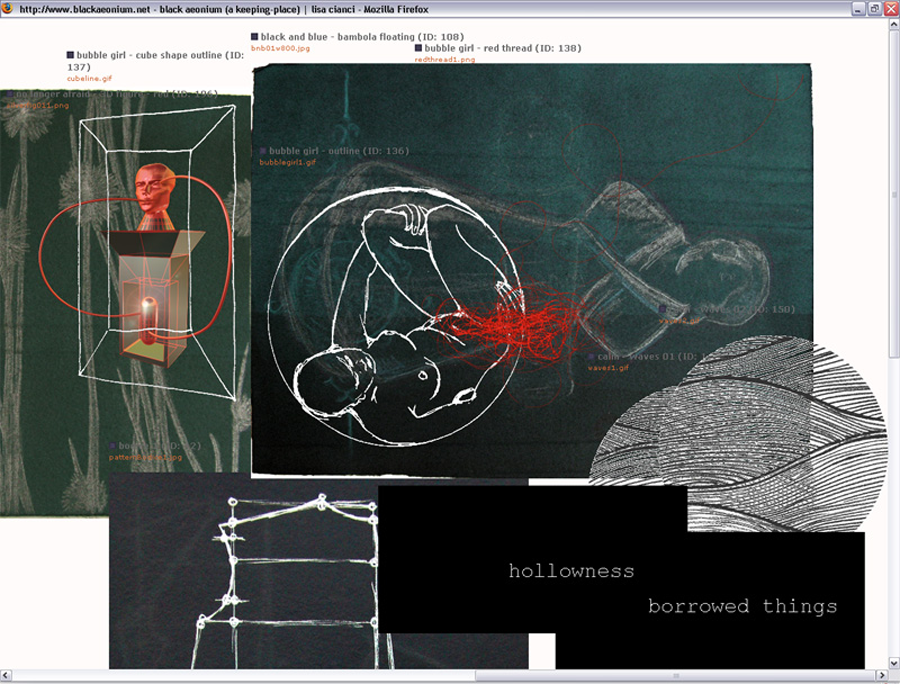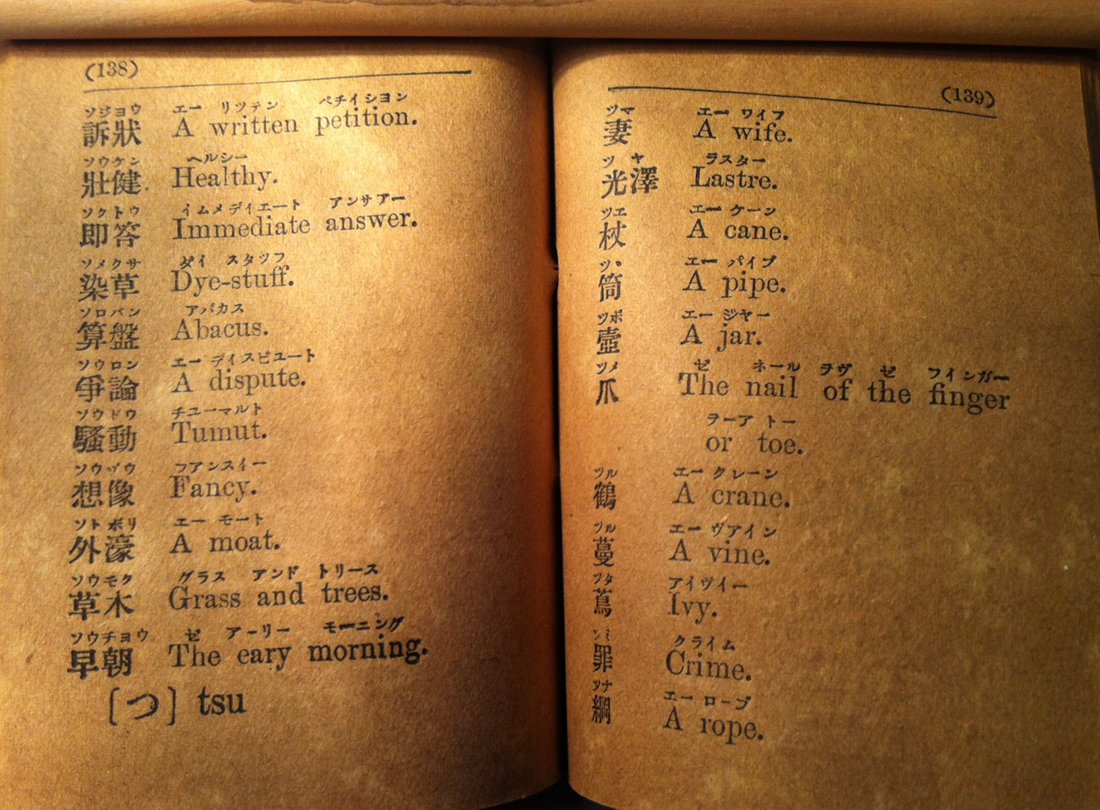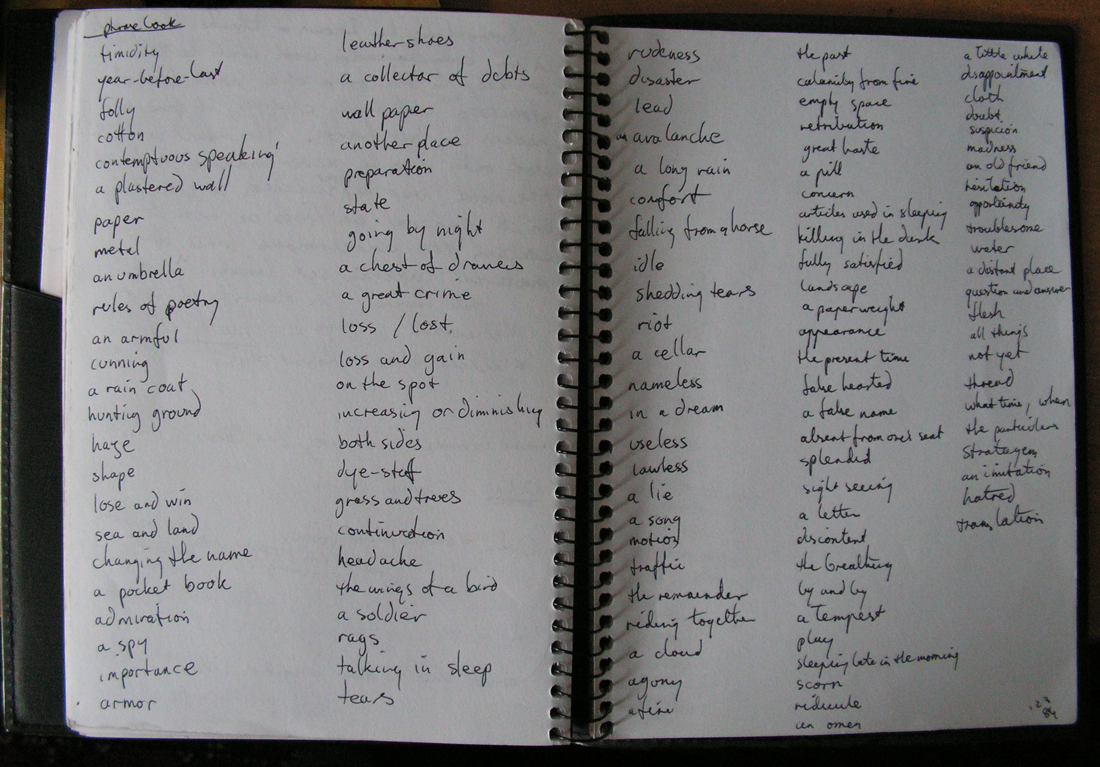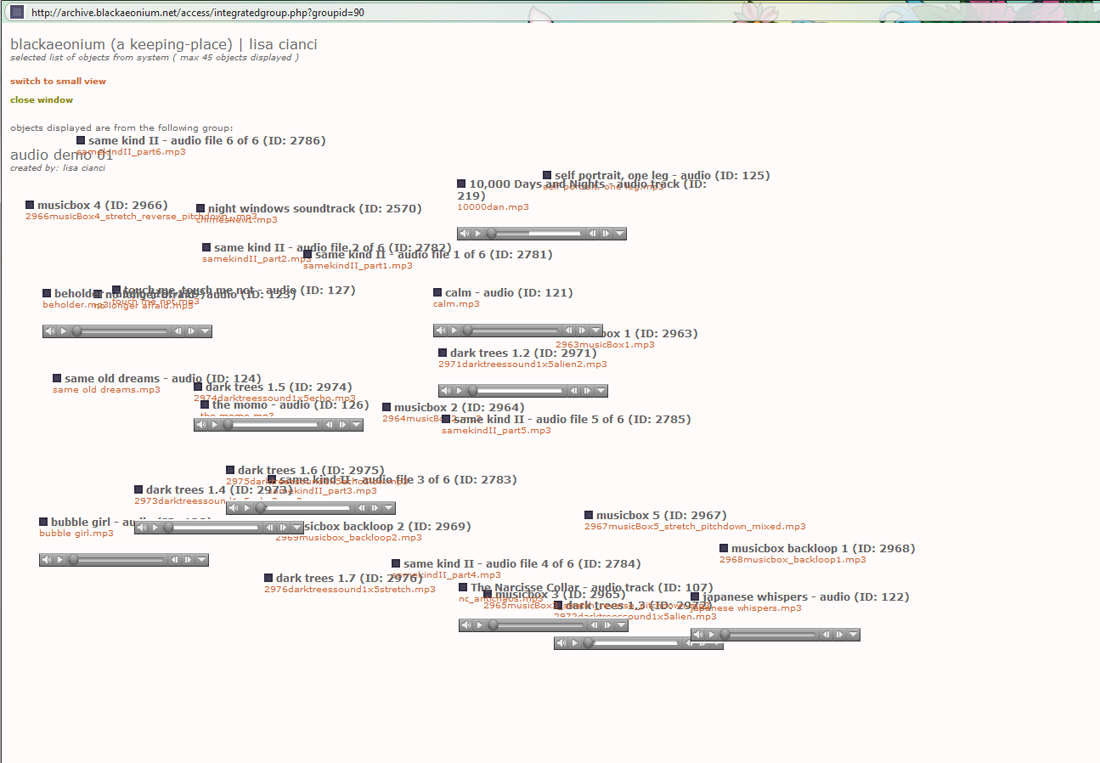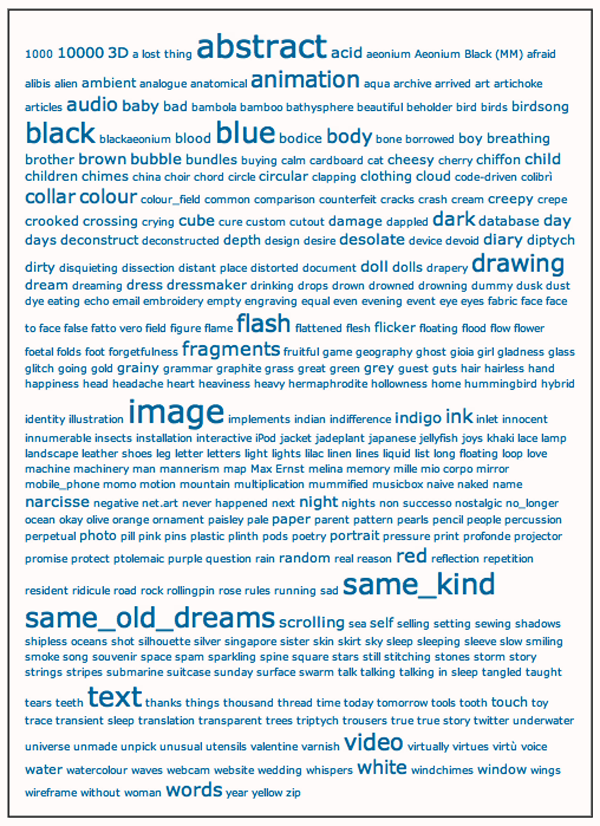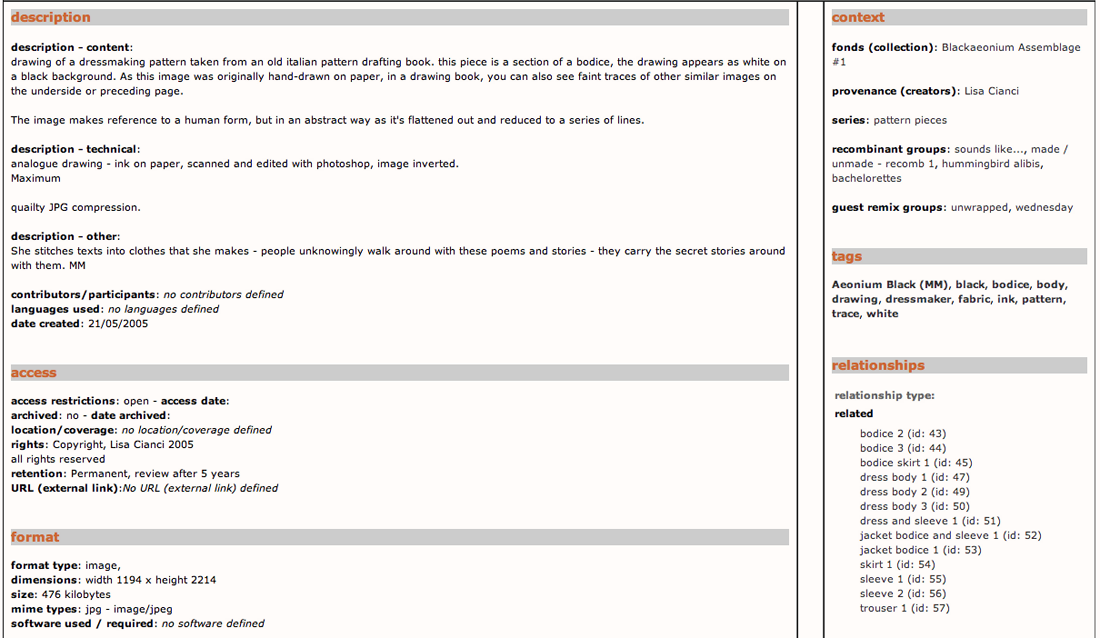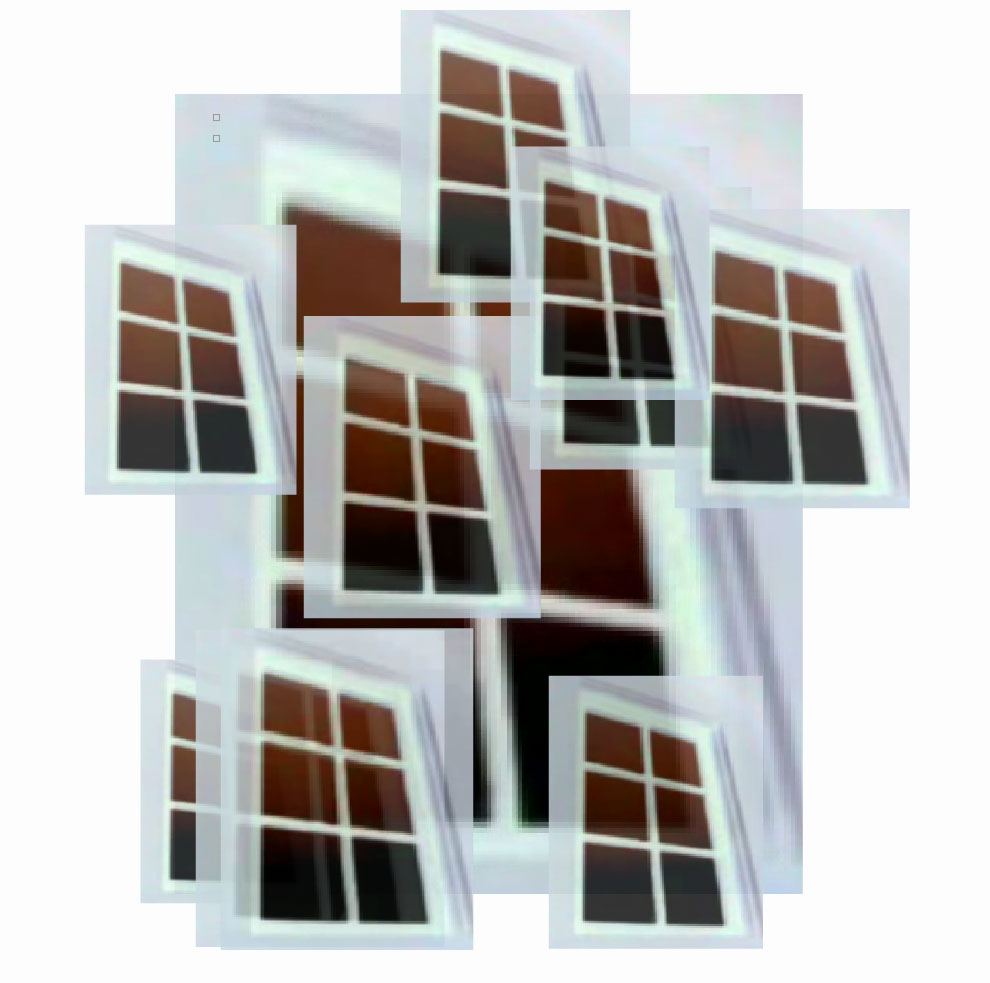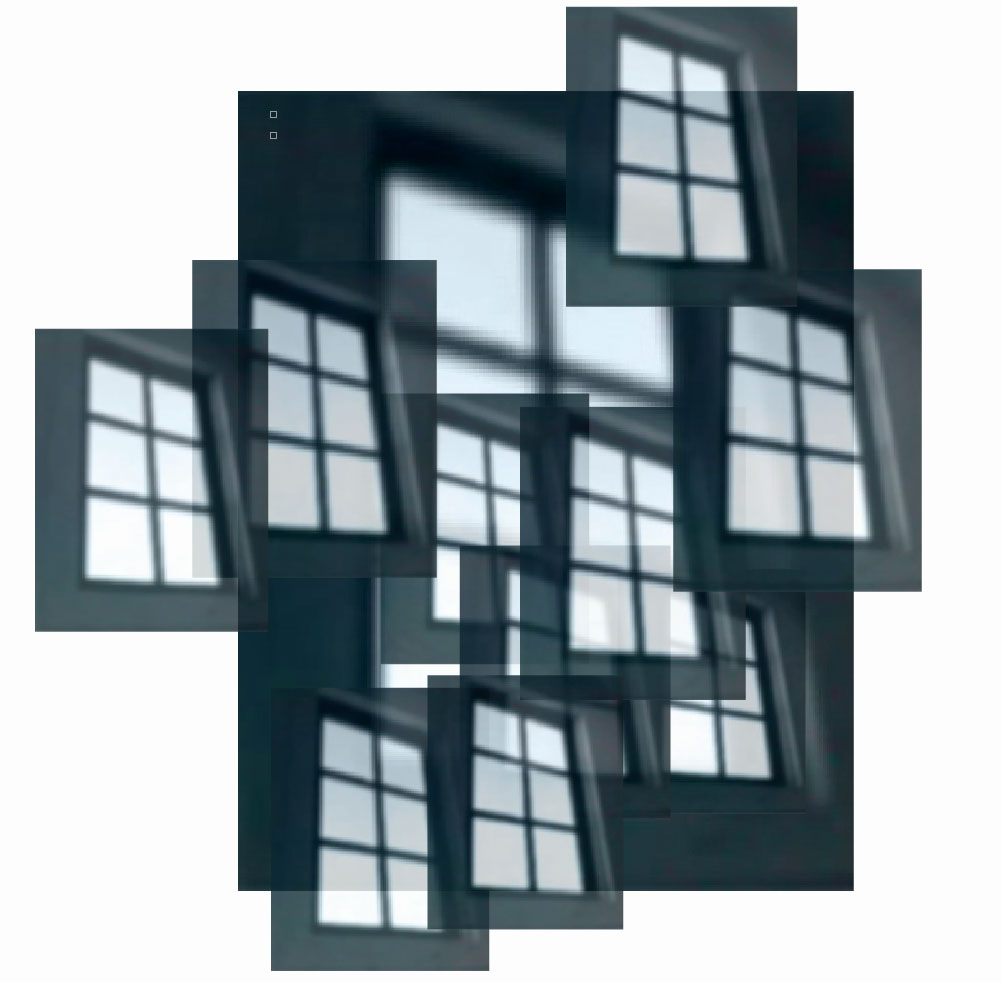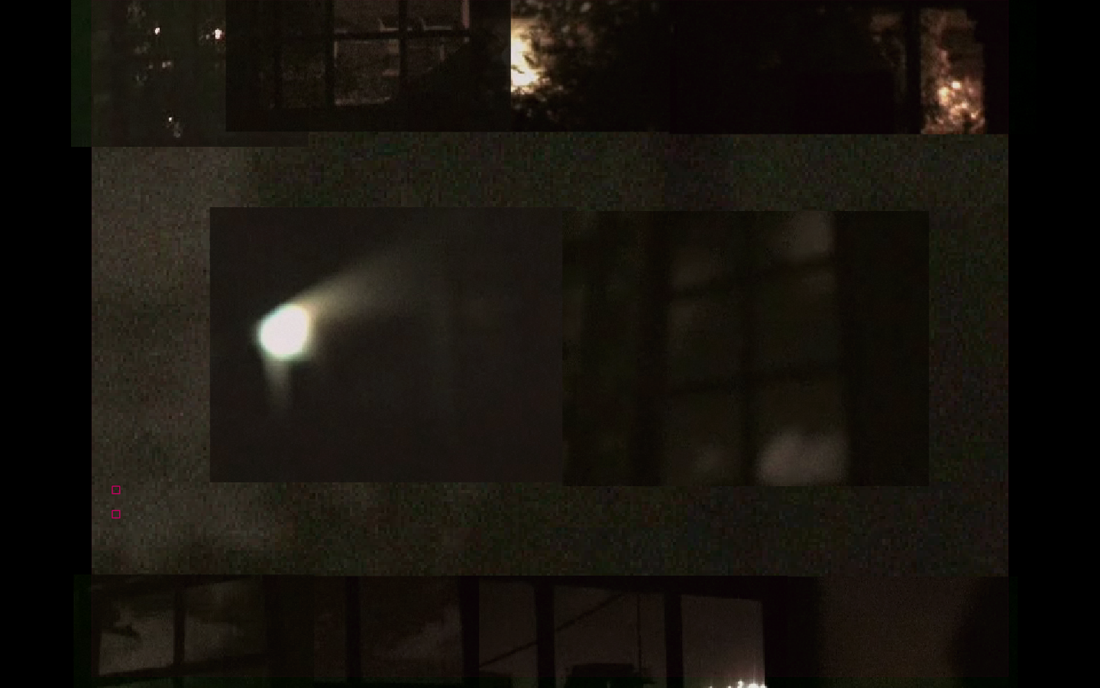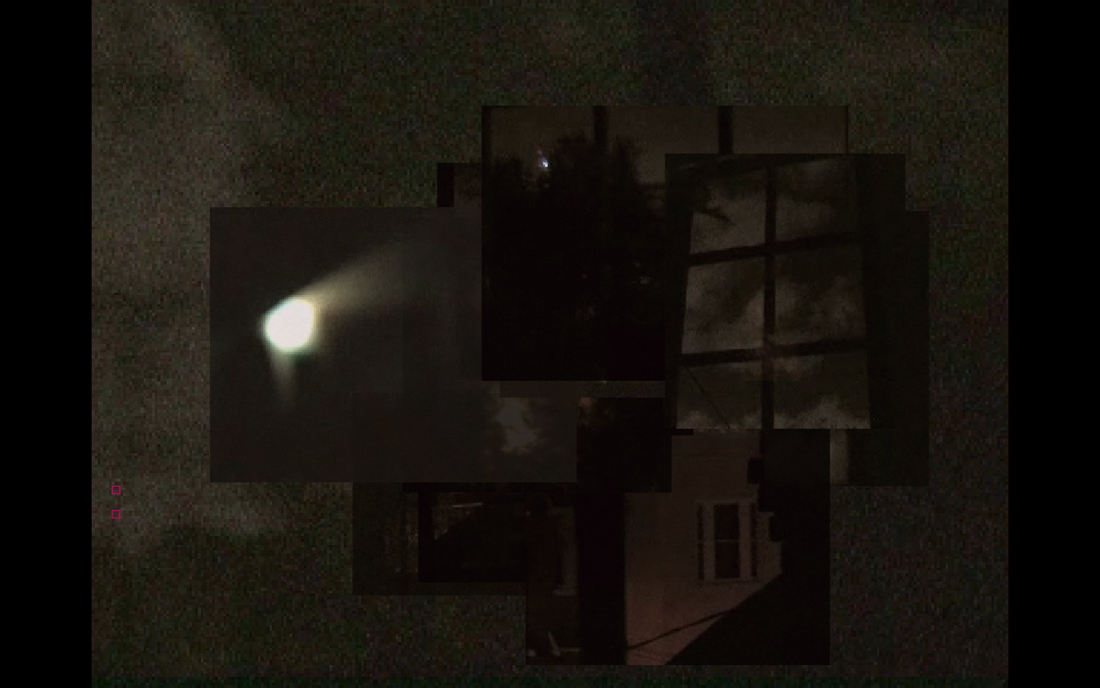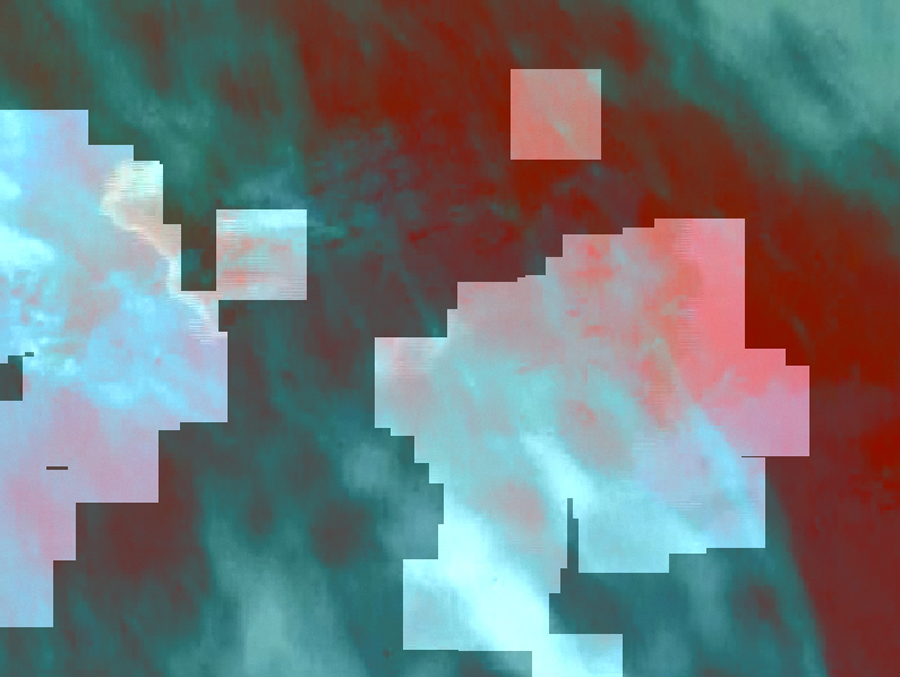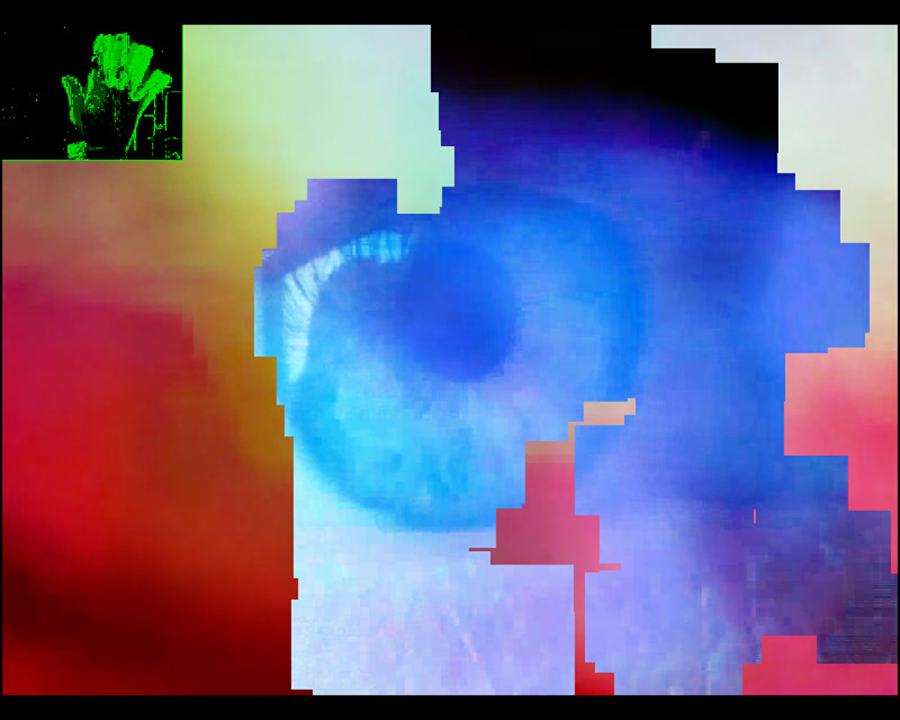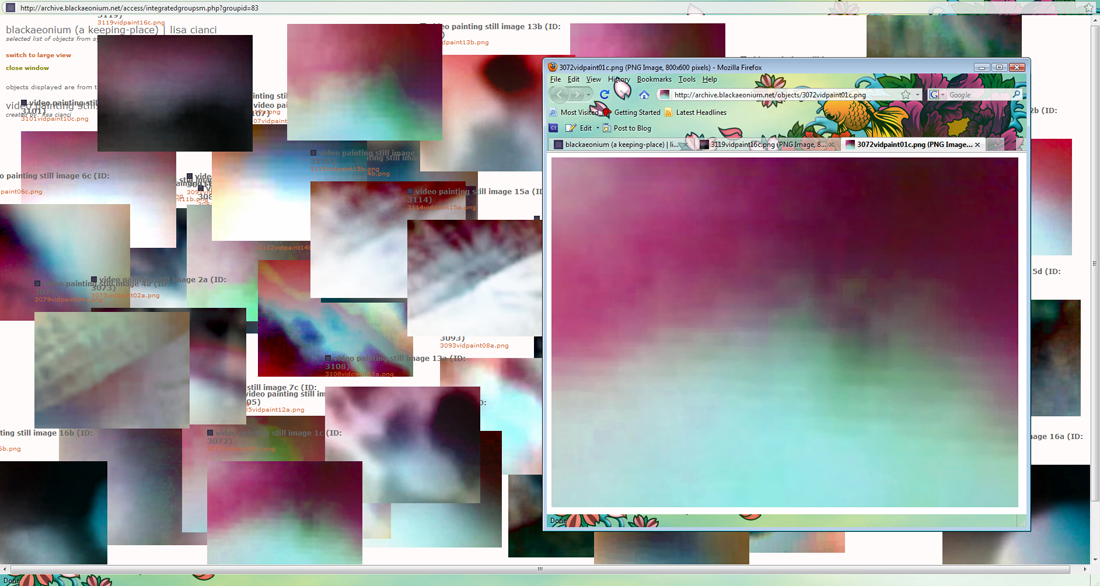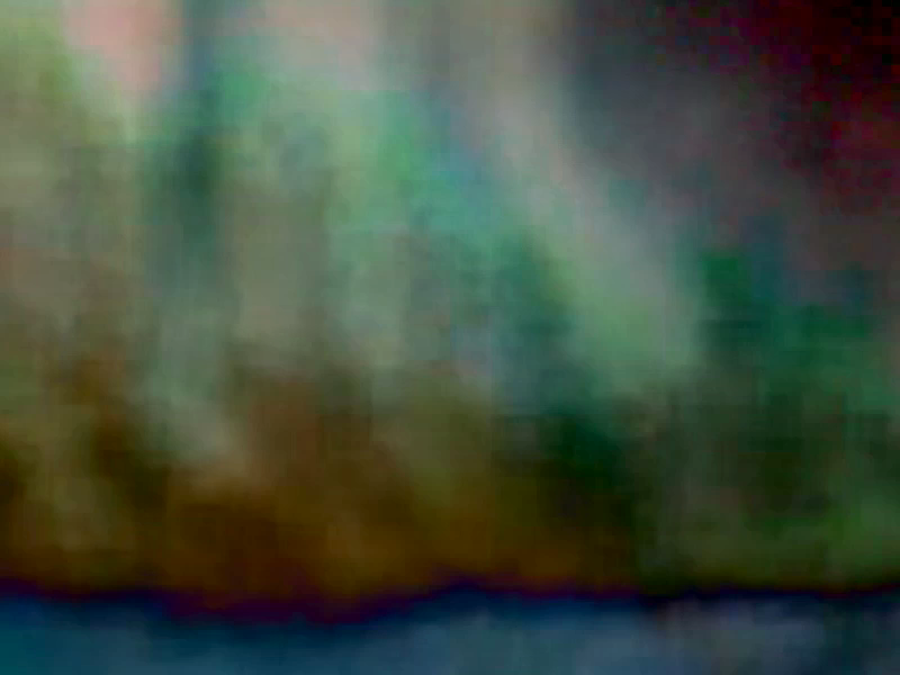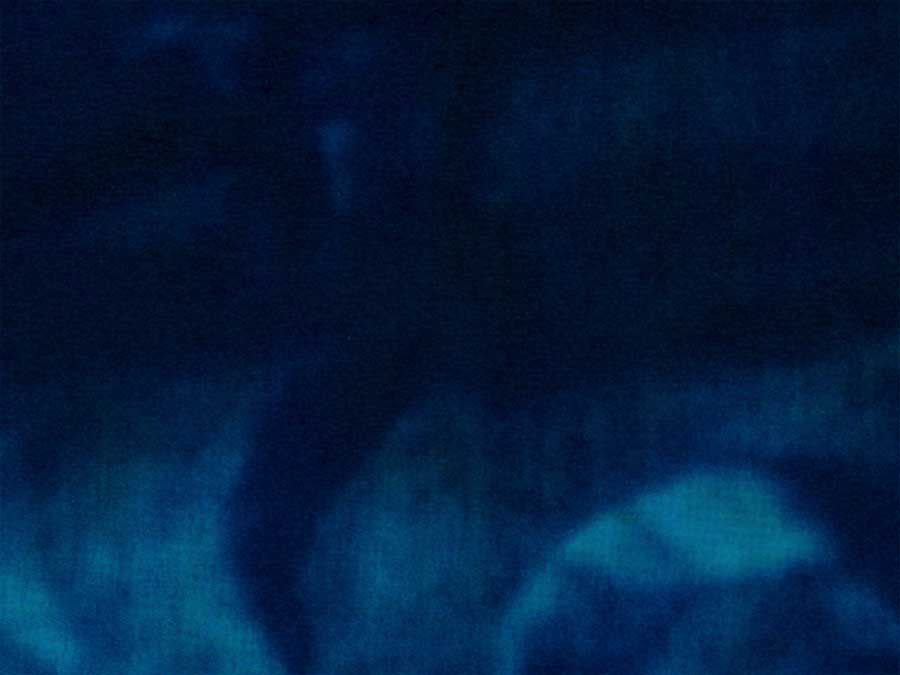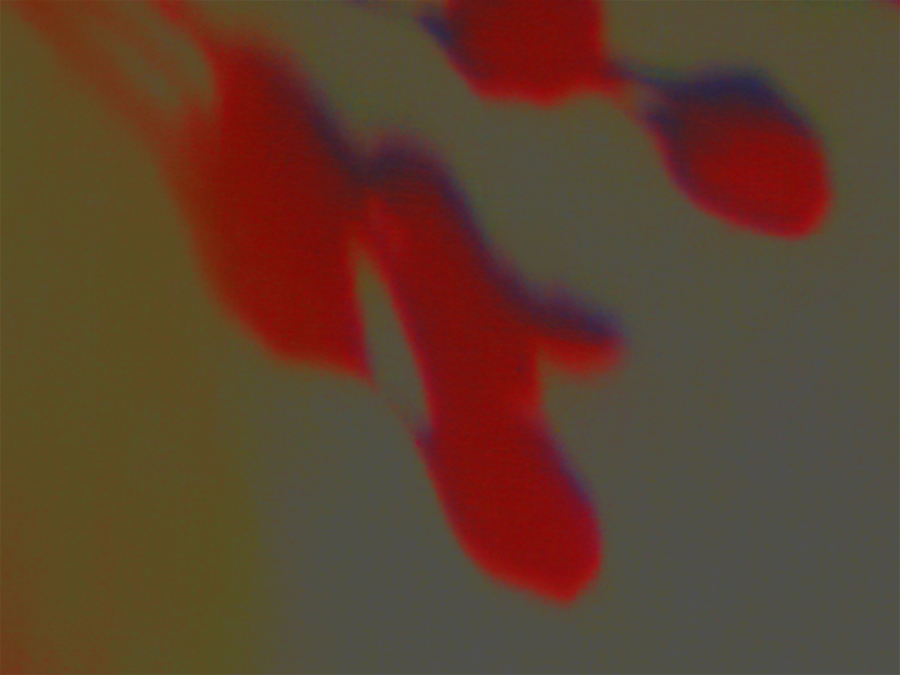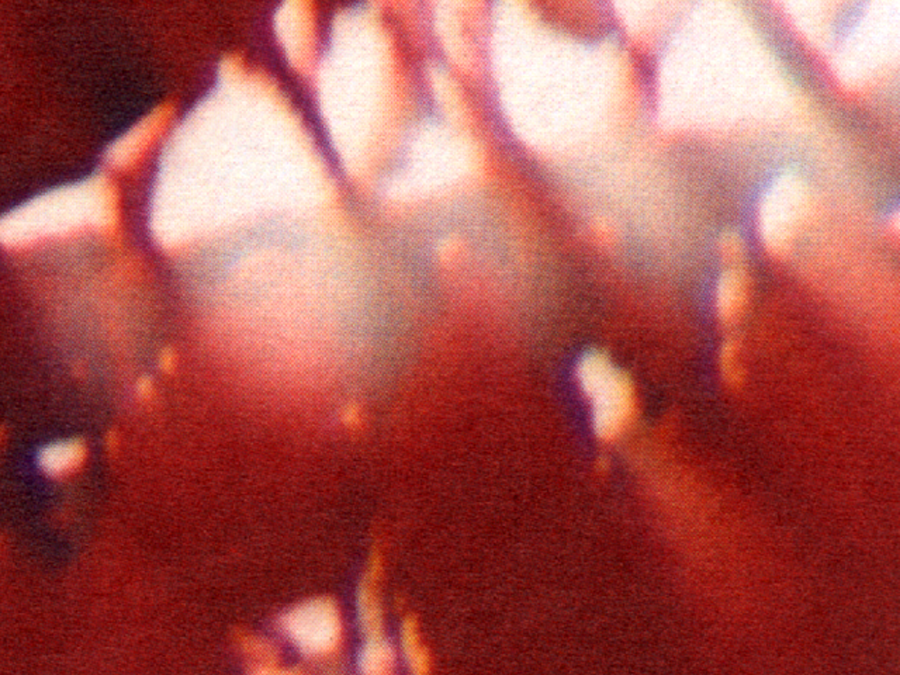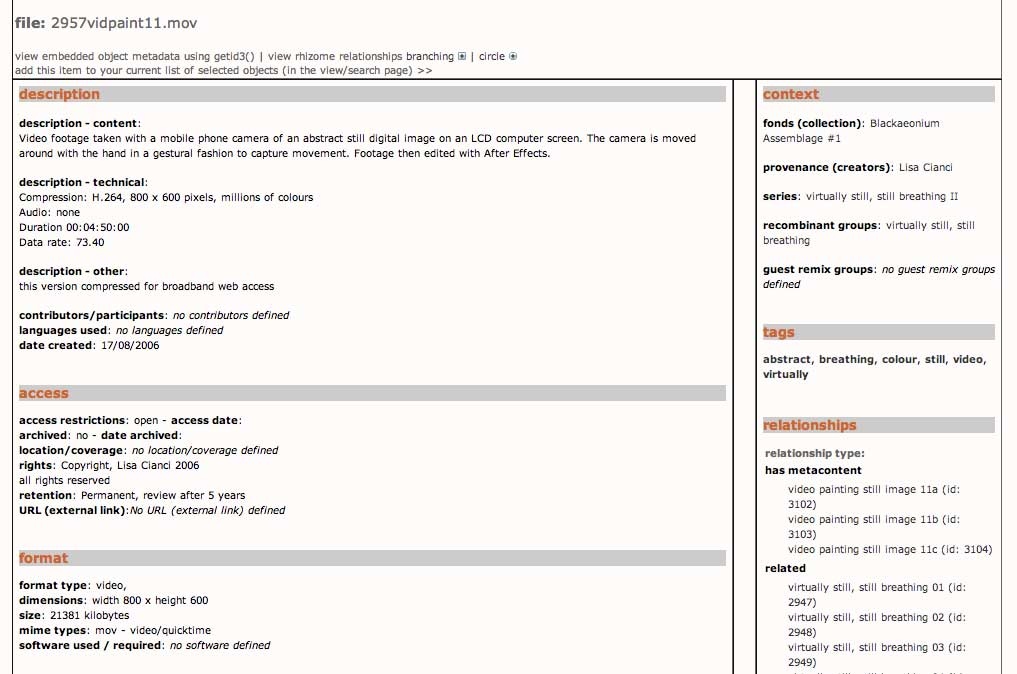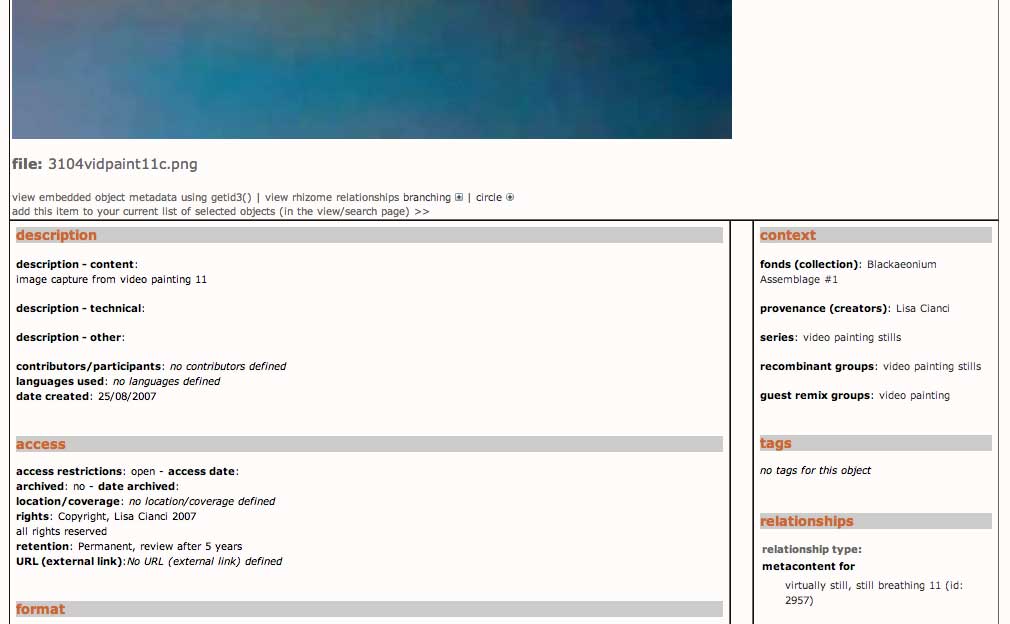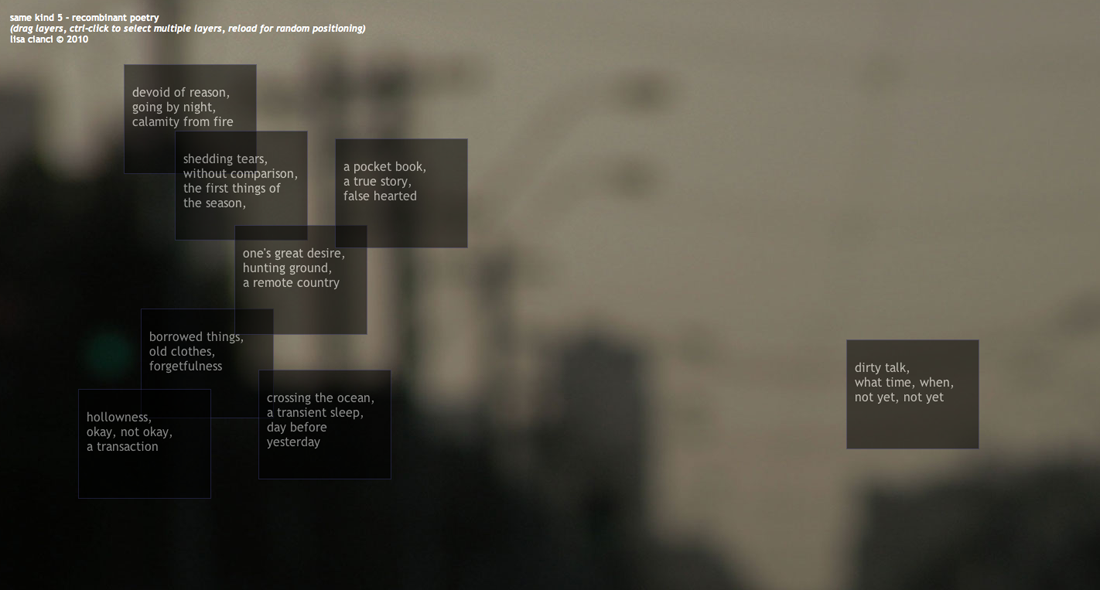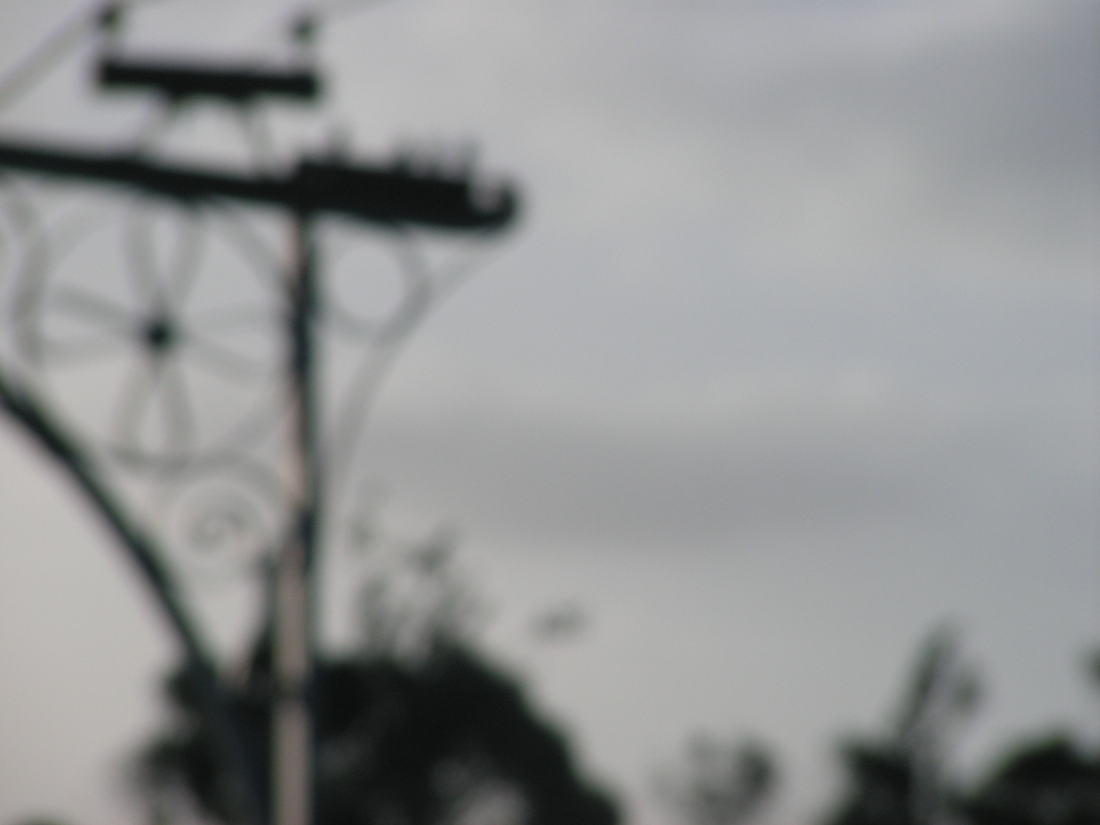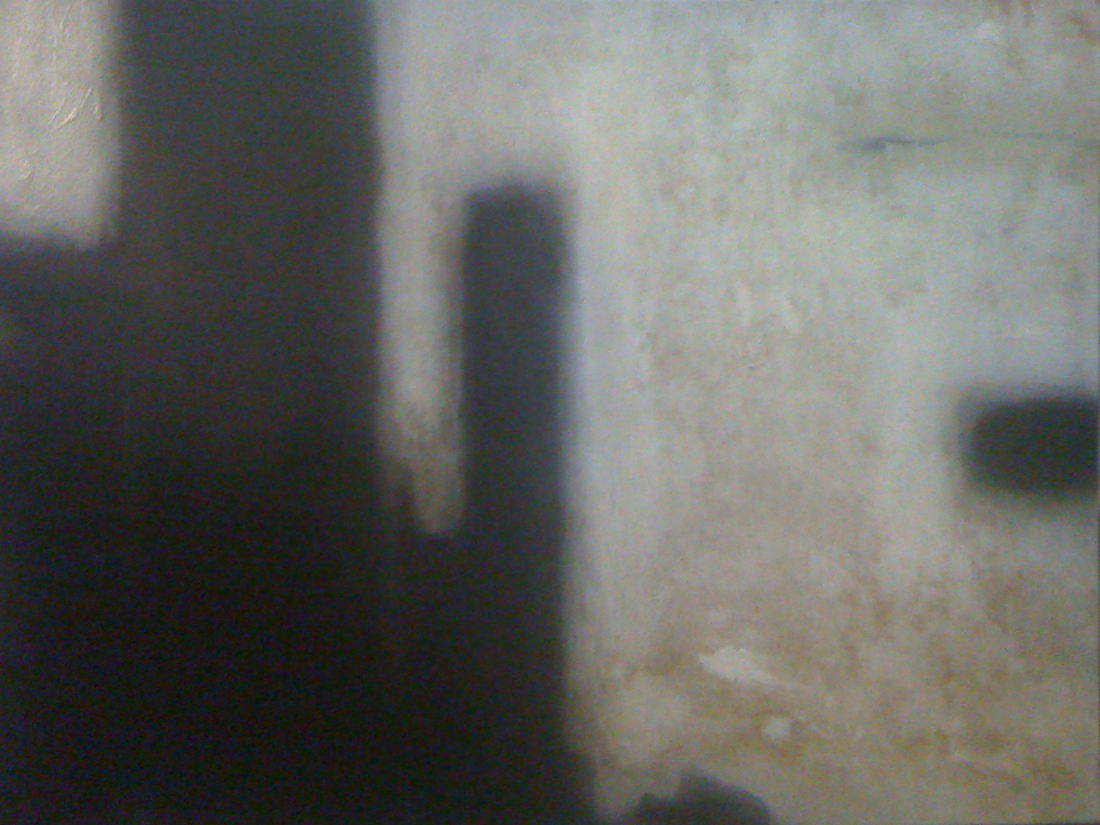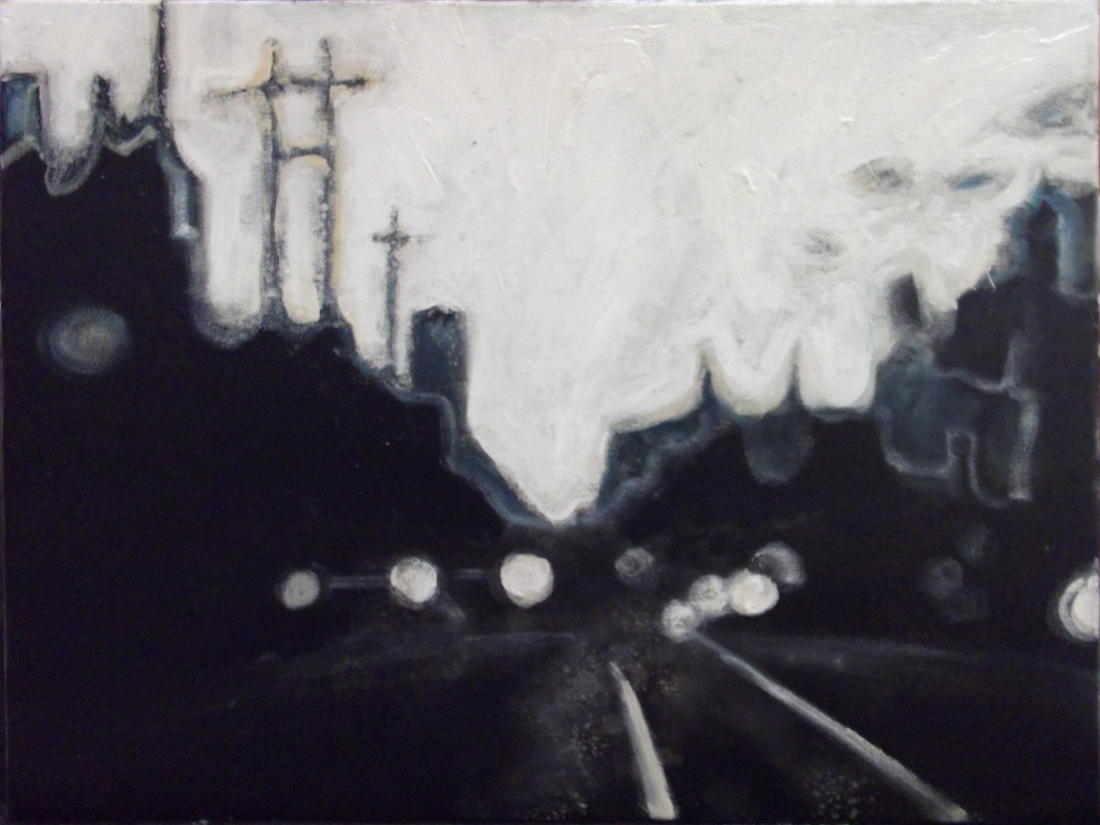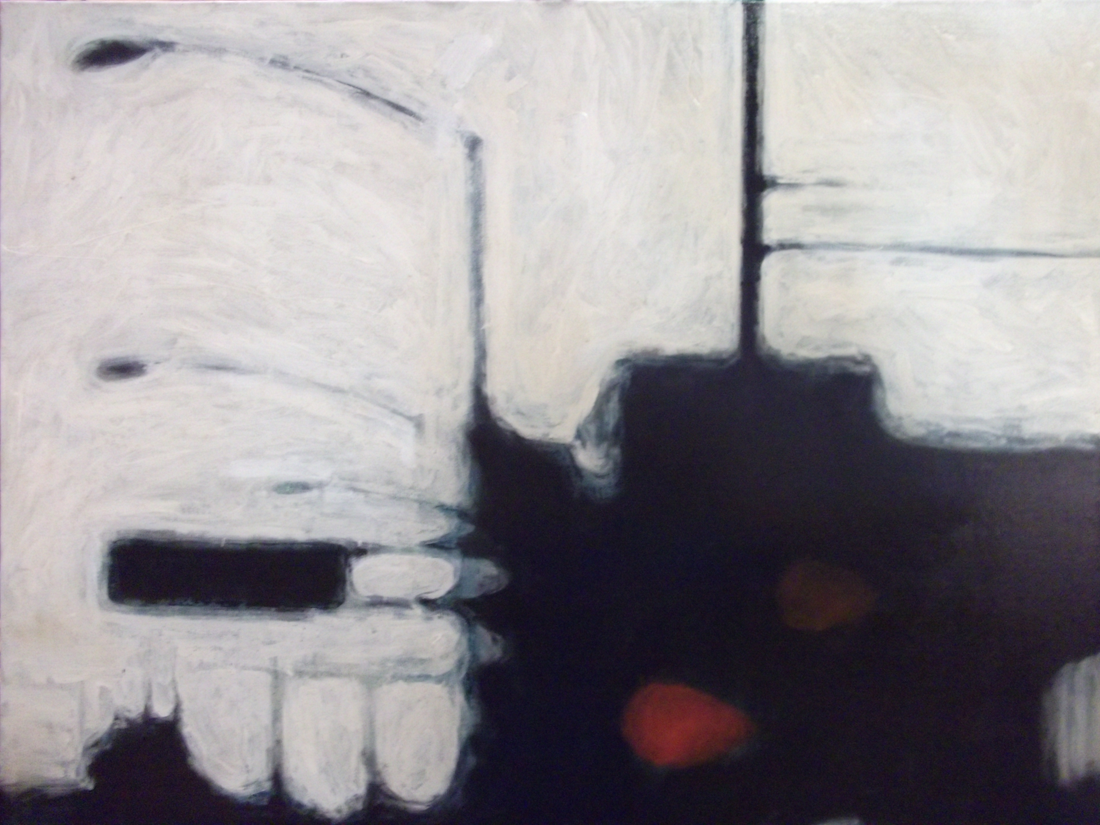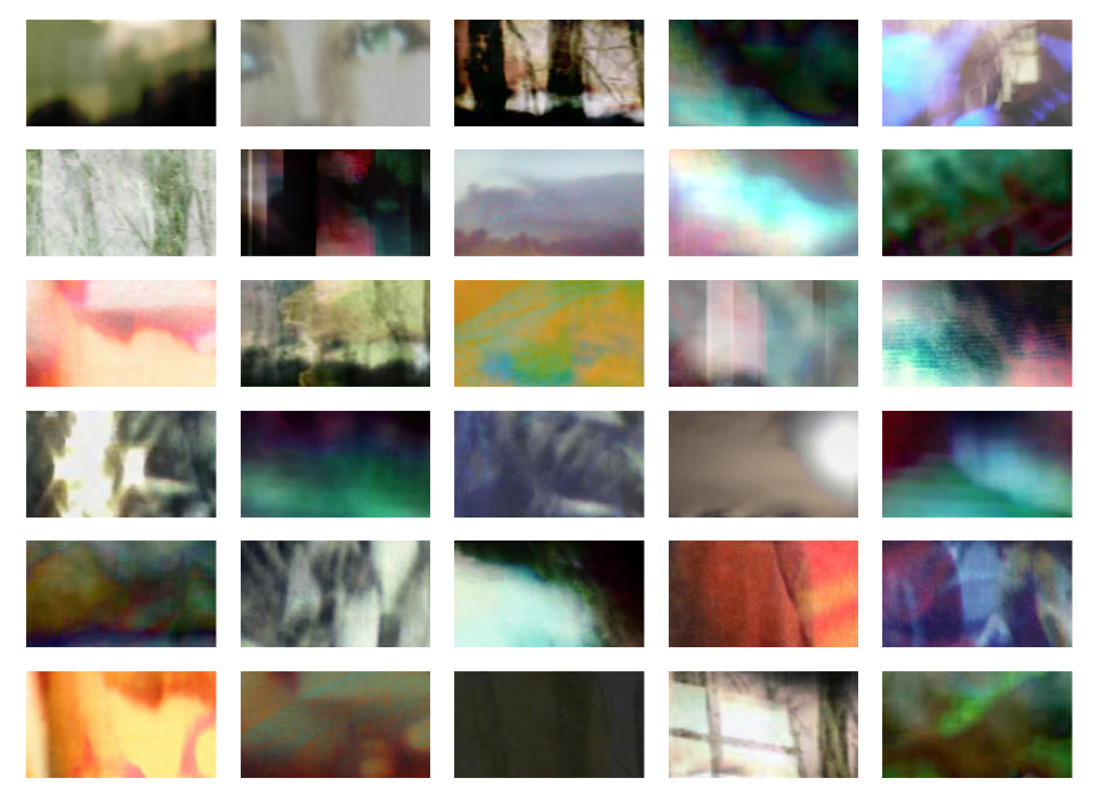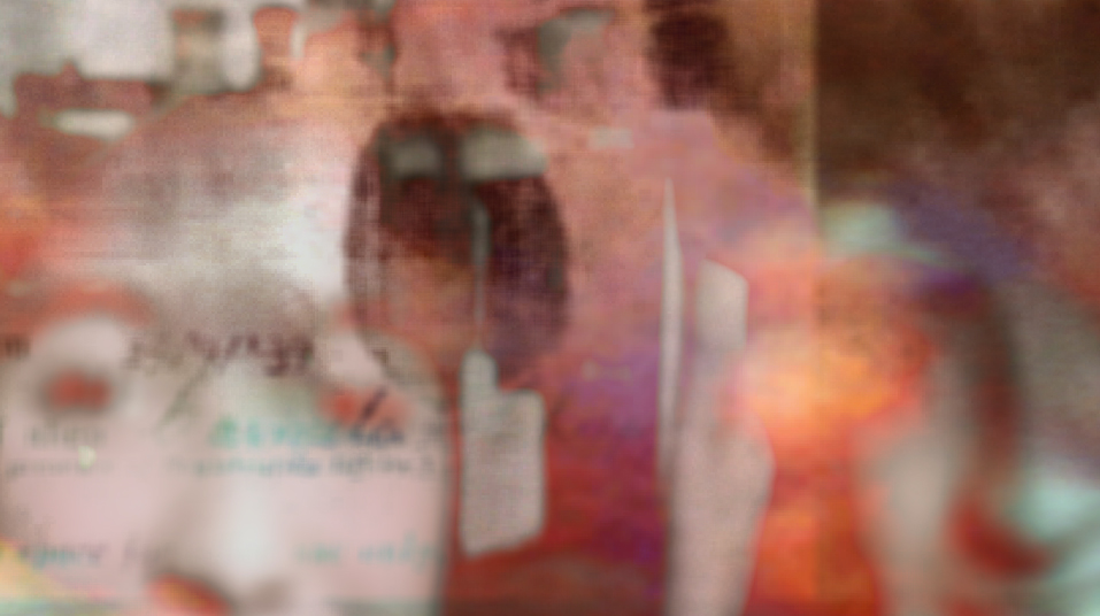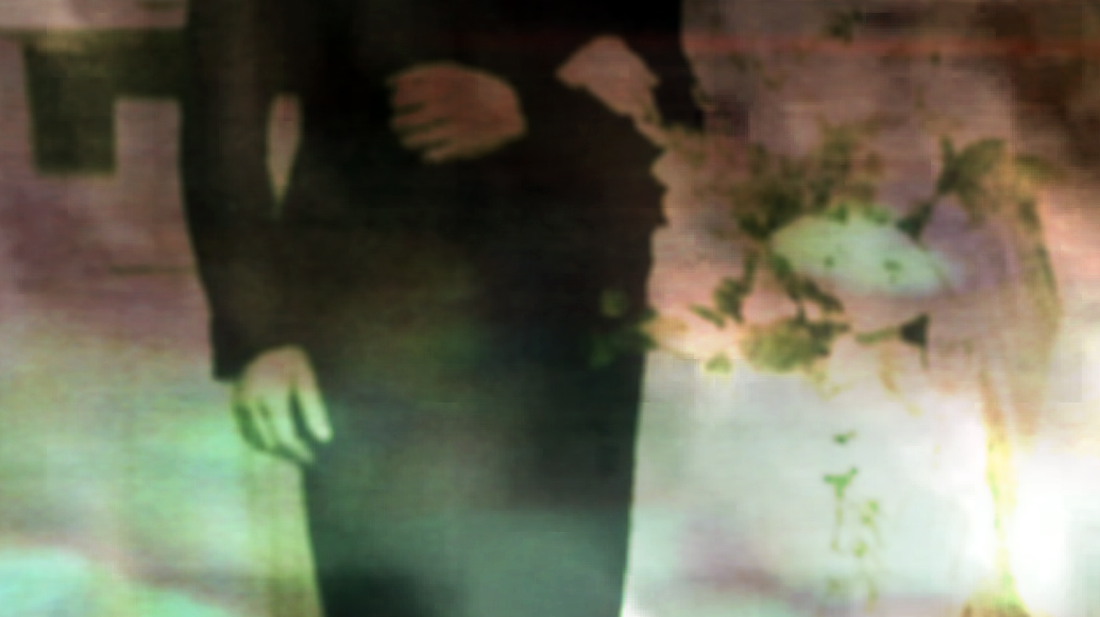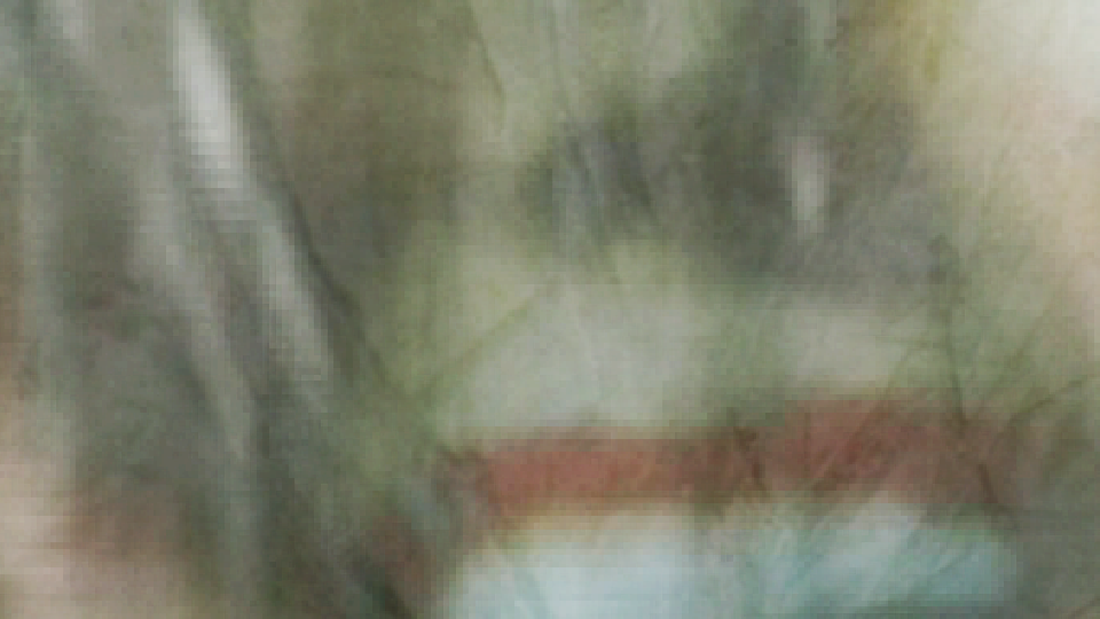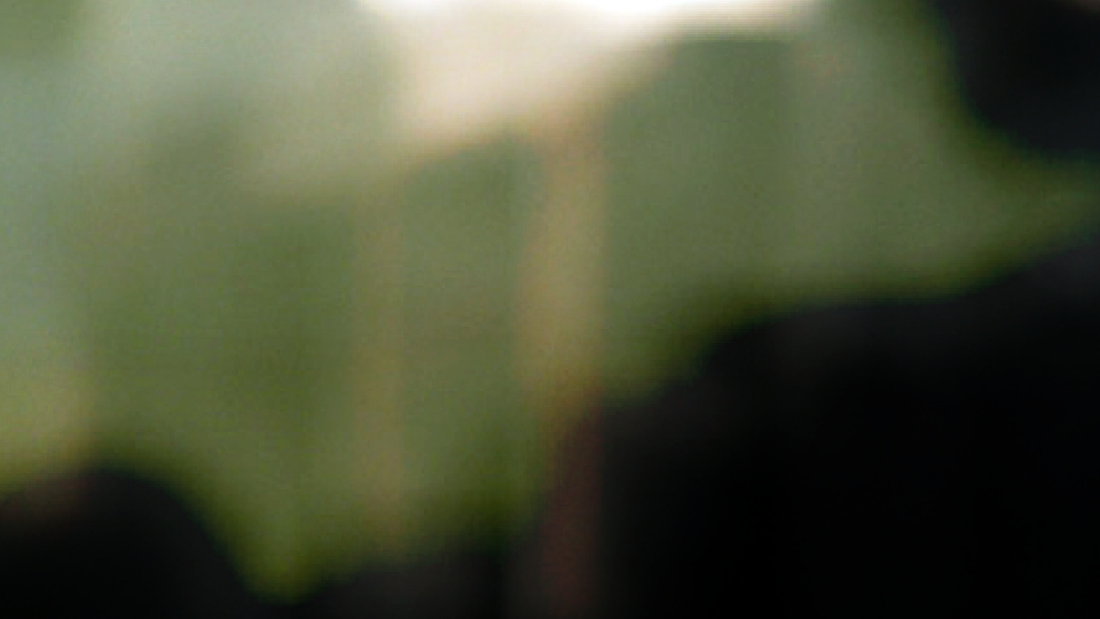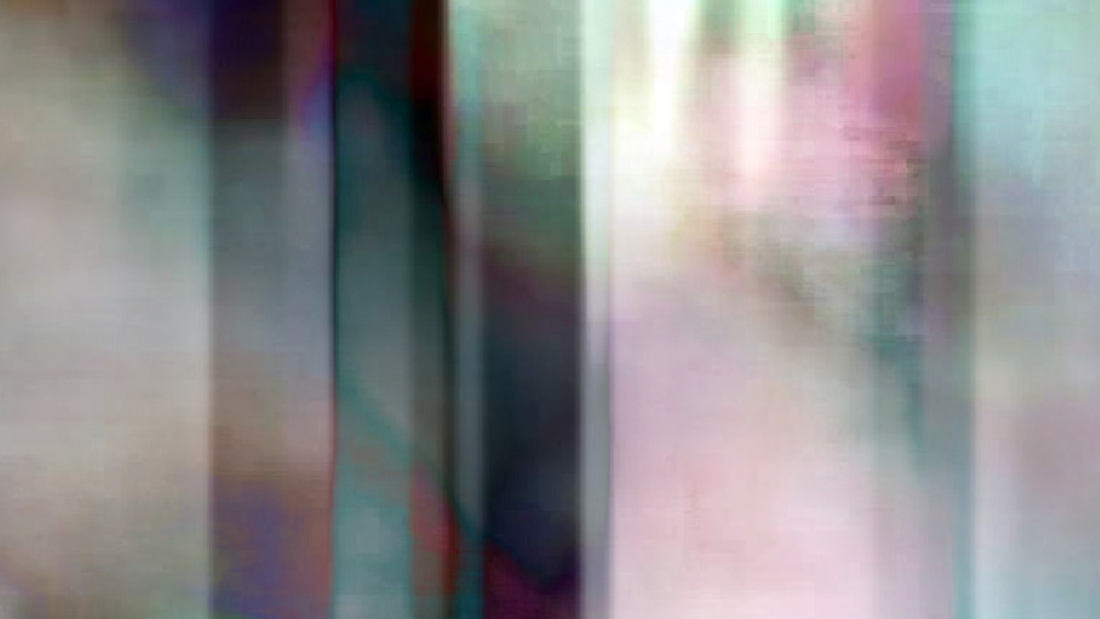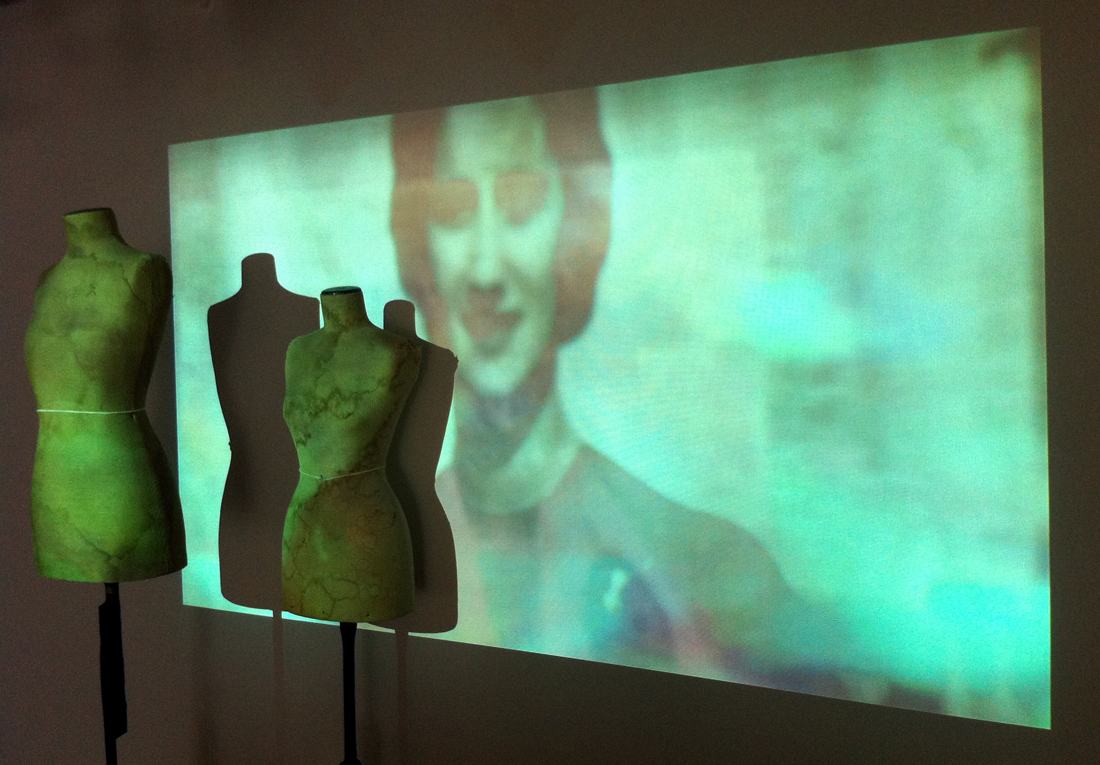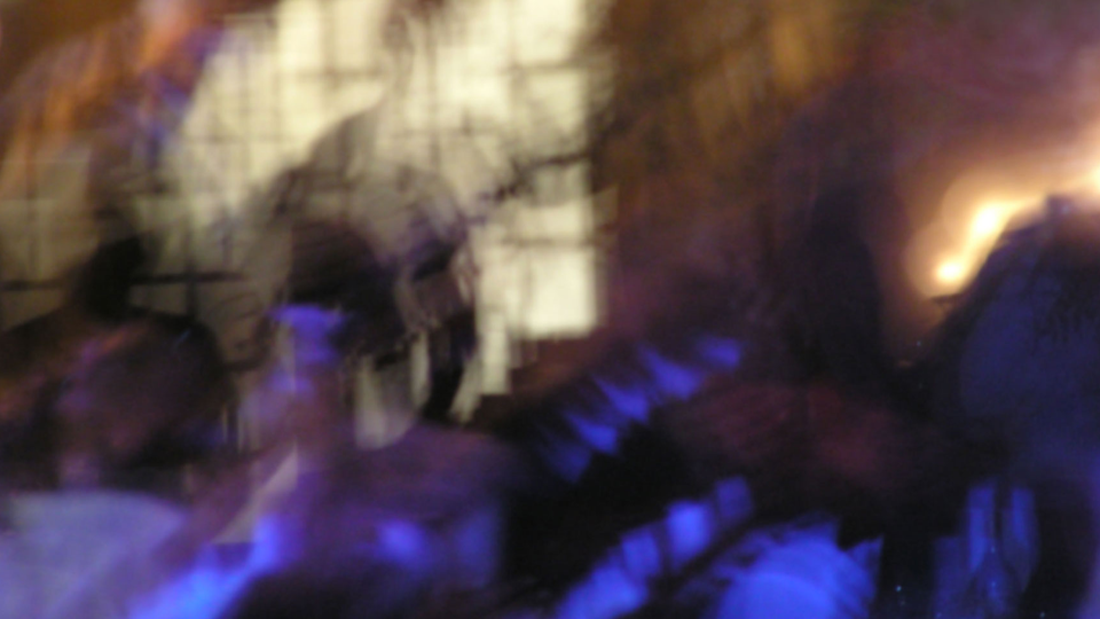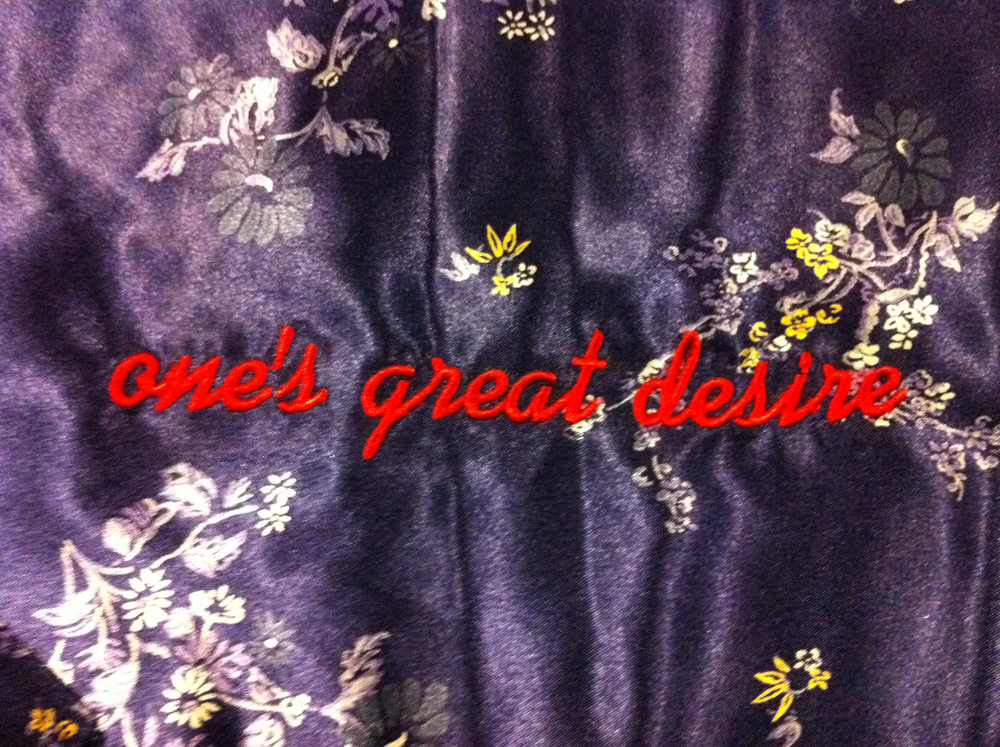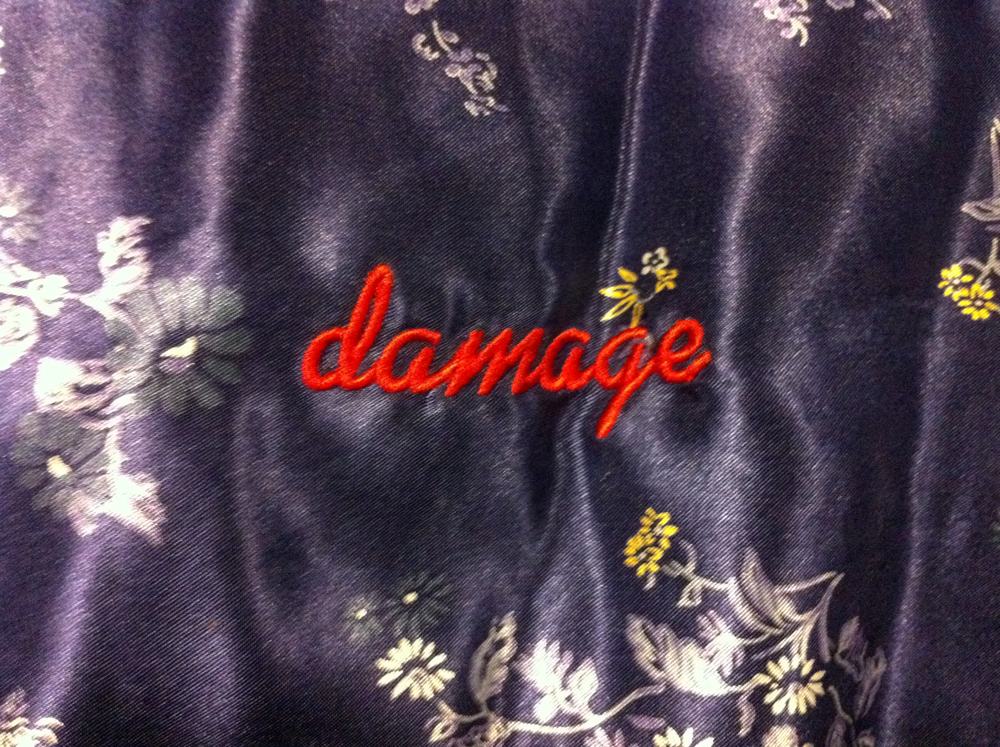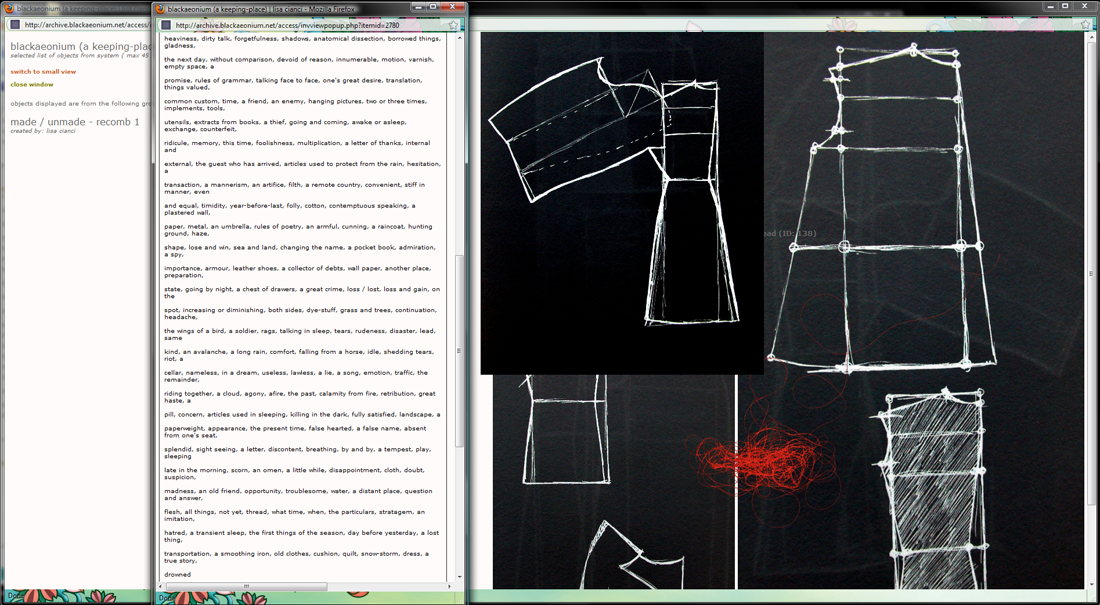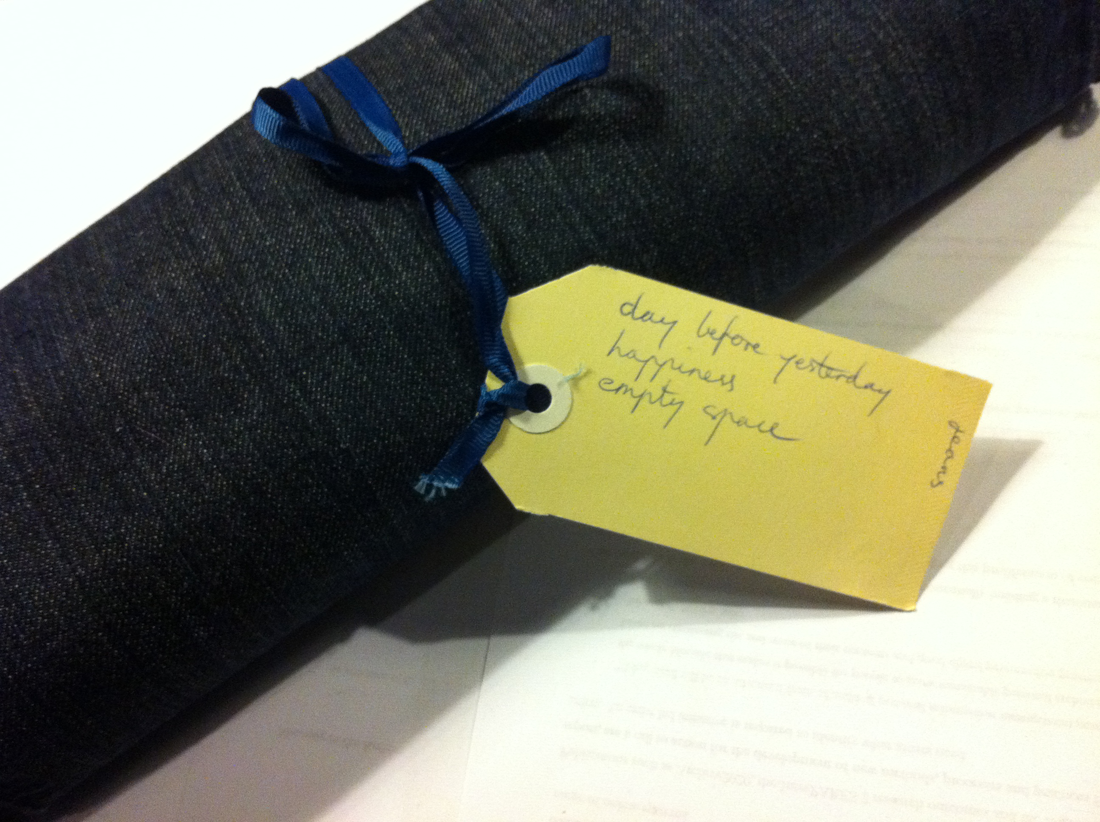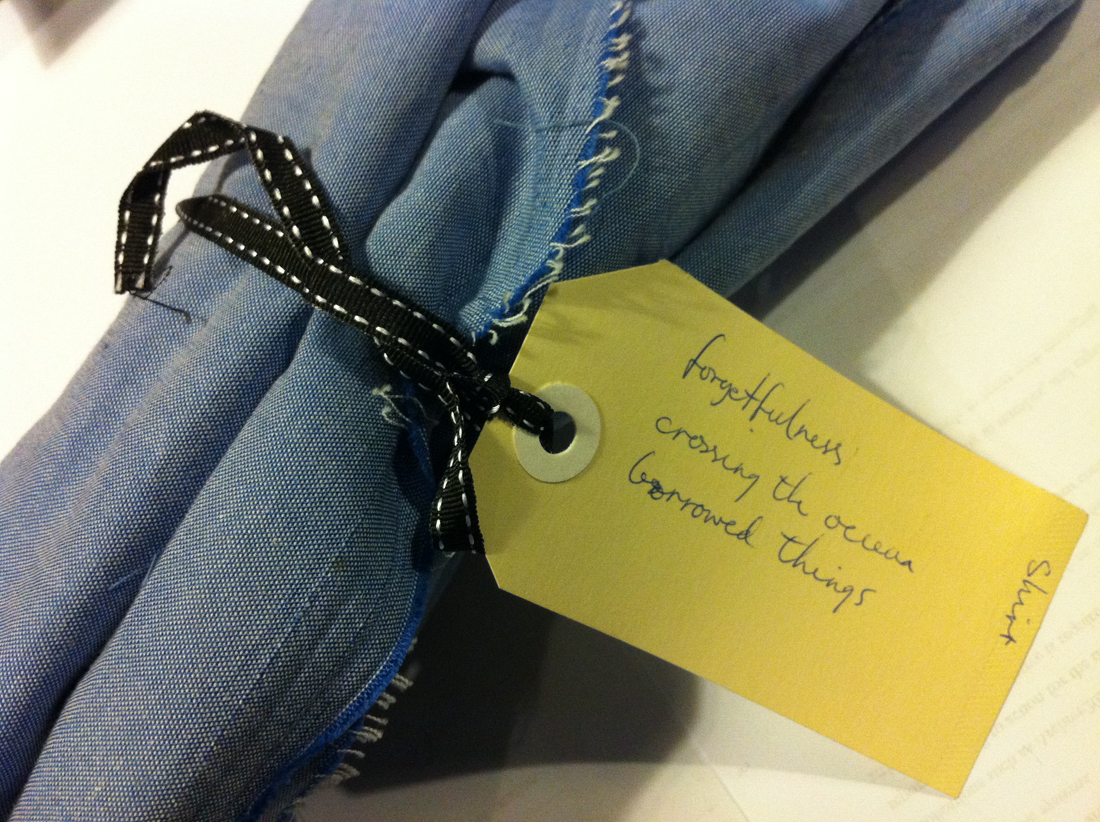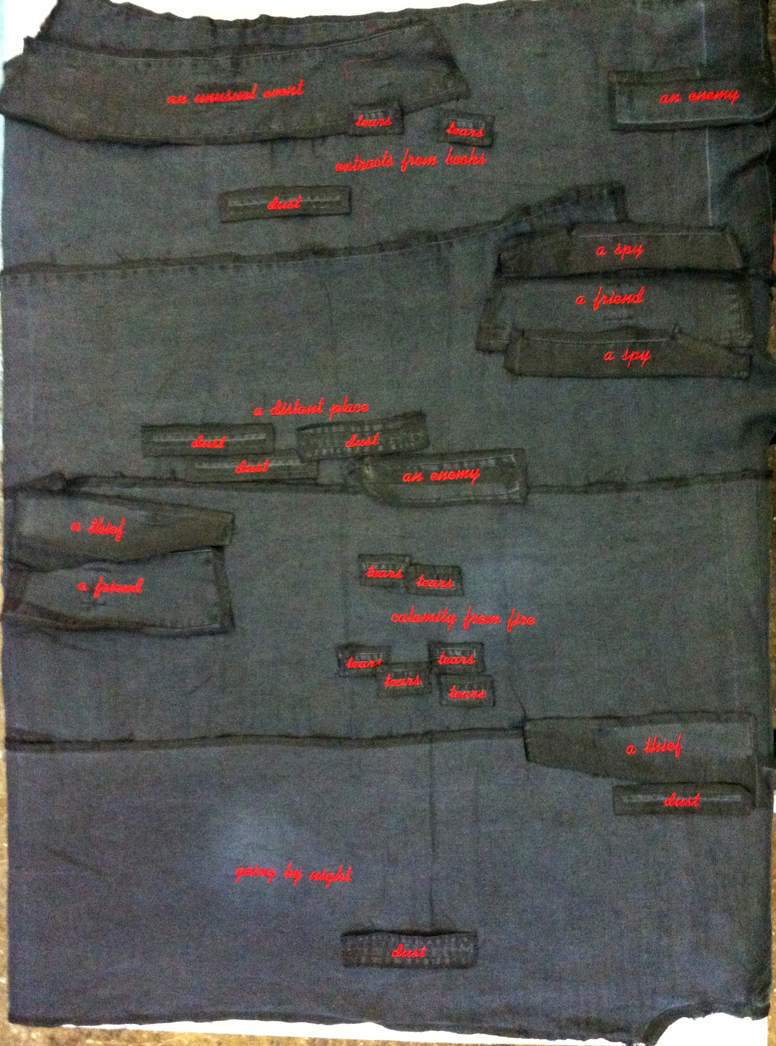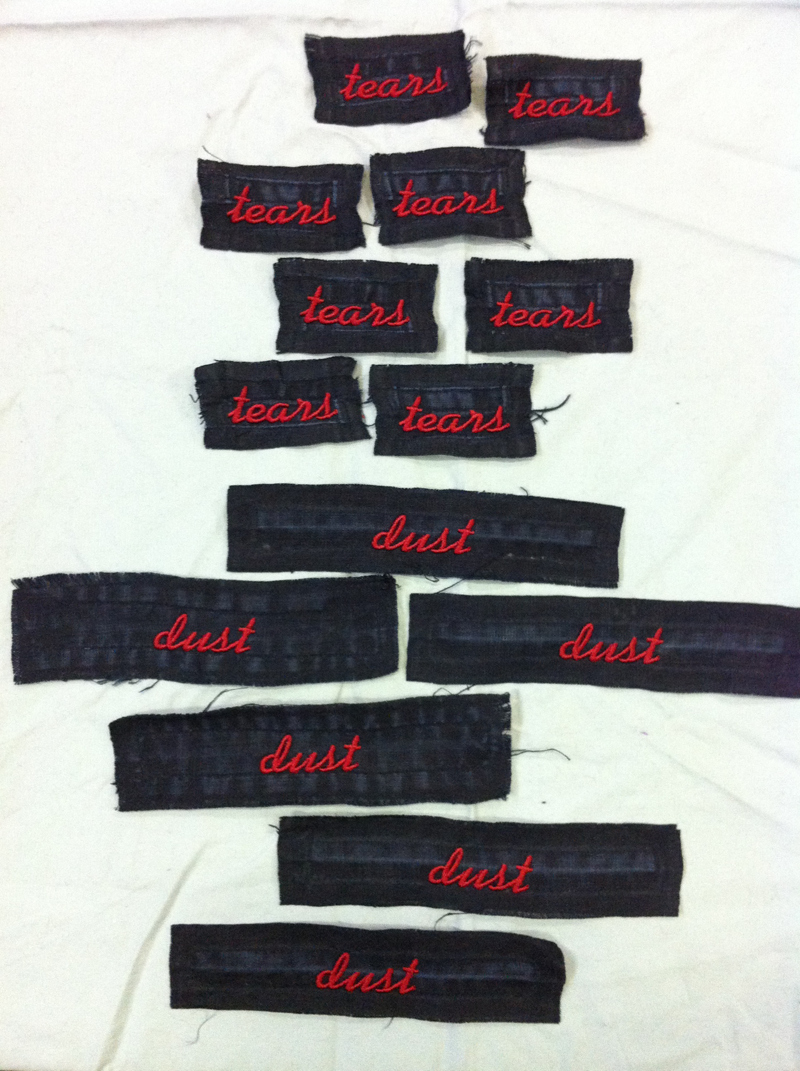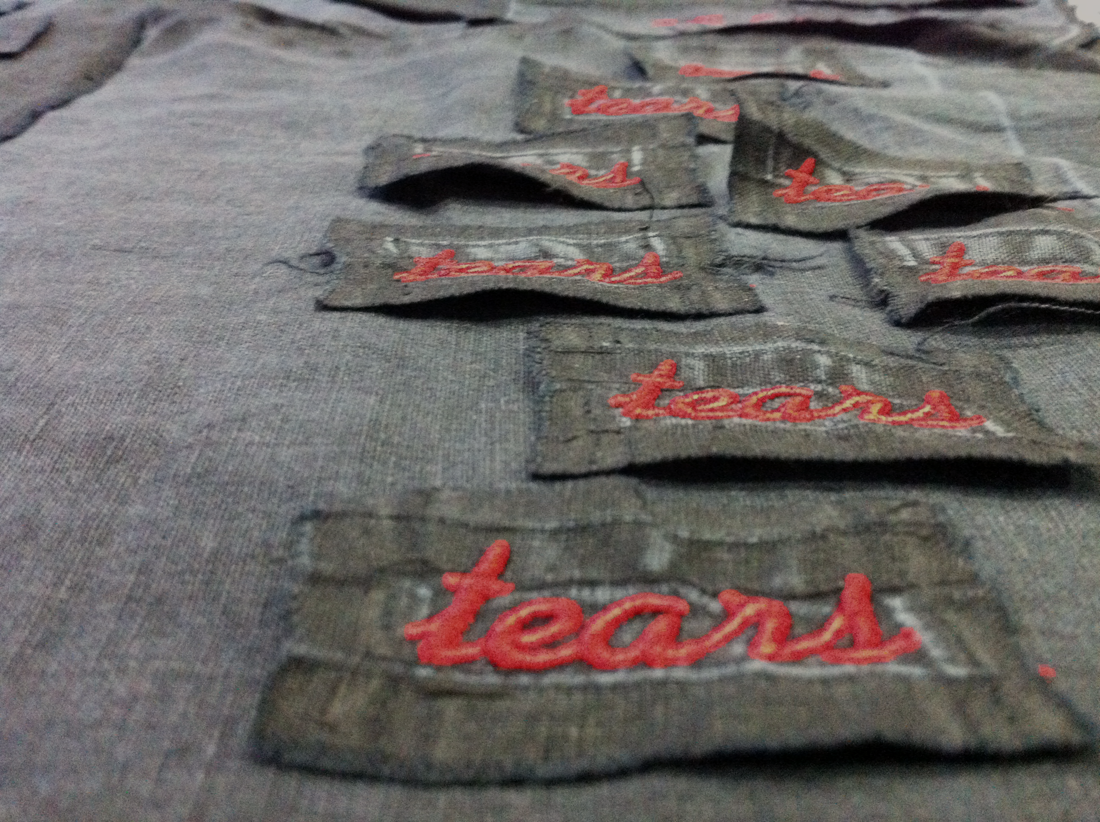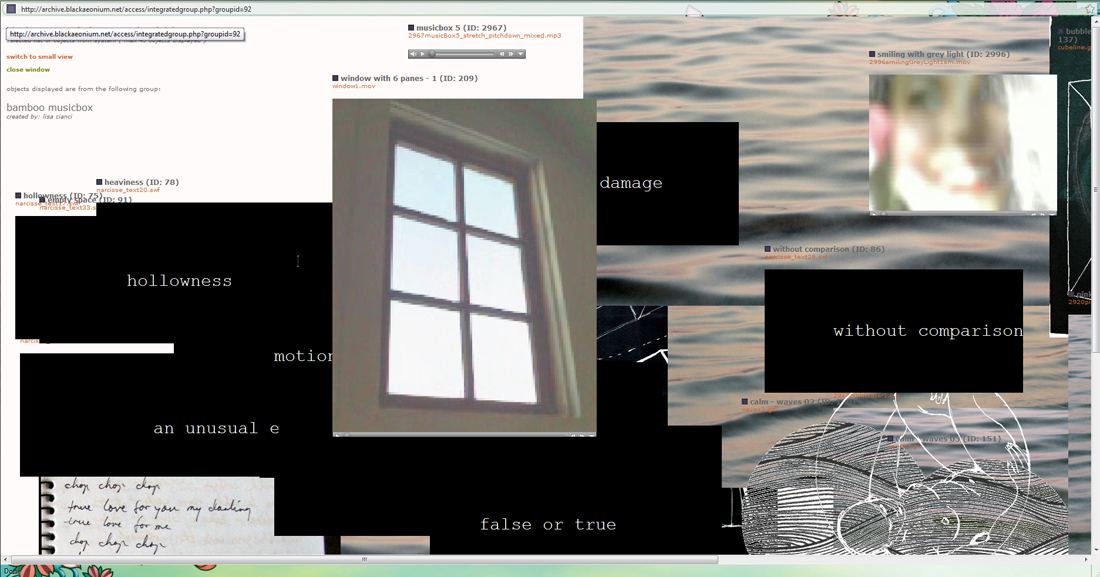homepage & table of contents >> chapter 3
On using the Archival Assemblage: 9 examples of creation through the Blackaeonium archival system
Recombinant works in the archival assemblage
In the age of the prosumer the spectator becomes, in turn, producer. In the age of remix, contents survive in a thousand and one ways, in a thousand and one different formats, redefining themselves in an infinite loop of production of meaning. […] If we go from asking ourselves: “why archive media art?”, to asking: “what should we archive?”, and from there we advance to “how to archive”, we can see how we move from, on the one hand, archiving objects to archiving processes, where, besides the conservation of original pieces, recourse to documentation becomes an indispensable tactic for the survival of the foundational material that history is made of. (Alsina 2010)
I was aware that recombination and remix were occurring in my artwork before this research project began. For artists, many implicit creative practices in the studio are using what Eduardo Navas describes as an intertextual remix – “everything is intertextual” (Navas 2011b), which is “closer to the tradition of sharing ideas in conceptual and material form”. In the manner of a remixologist, I was seeking to combine areas of my creative practice involving remix with the archival methods I had experience with, and use the digital technologies I was already familiar with to make something different.
Remixology is the science of continuation and the art of drastic remaking, total remaking, remodelling.
(Eshun 1999)Once a substantial quantity of items had been documented in the Blackaeonium archival system, I was able to begin experiments with the content, to test interfaces and functionality I had developed, to create recombinant artworks through remixing selected items via a number of methods from random accumulations; careful searching and selection; and theme-based narratives. Here I have described a selection of the many recombinant works in the archival assemblage.
Remix and Glitch – Narcisse Revisited
This flow forward in reverse results in the Glitch or as 'the spirit of that time of what the glitch was' or had occurred. At that moment in time and of time-based media... of traces of tracings of what has past... we are left with all that has been left (behind) and embedded by digital and analog systems, all of which include and express themselves over and over again, in times, as specific as formats failing or found to be debris, broken bits of histories awash and washing up against the shores of what we thought we knew, against the grains of our expectations. (Cates 2010)
Figures 3.01 – 3.03 "Narcisse Revisited #2" 2007, recombinant work from the Blackaeonium archival system
HTML/Flash/jQuery/audio/ image & video
(click to view larger images)
There is always some kind of loss in the creative process, as Jon Cates suggests. Certain artists work with “lossy” digital and analogue media as their creative practice. Glitch Art is sometimes associated with Remix Art, although most of my forays into Glitch Art have been accidental – a glitch in themselves, usually not intentional[1]. Some proponents of the Glitch Art genre construct scenarios to intentionally use glitches in their work. There are also some relationships between the Glitch and preservation issues, when the use of Glitch is employed to make a statement about the fragility of our variable media. Rosa Menkman (2011b) is an artist who purposefully uses glitch to create artworks (Figure 3.04), and her work involves analysis of the manifestations of glitch in current contemporary art practice.
Some artists intentionally elucidate and deconstruct the hierarchies of digital technologies. They do not work in (binary) opposition to what is inside the flows (the normal uses of the computer) but practice on the border of these flows. Sometimes, artists use the computers’ inherent maxims as a façade, to trick the audience into a flow of certain expectation that the artwork subsequently rapidly breaks out of. As a result, the spectator is forced to acknowledge that the computer is a closed assemblage based on a genealogy of conventions, while at the same time the computer is actually a machine that can be bent or used in many different ways. (Menkman 2011a, p.340)
Figure 3.04 "Collapse of PAL", image from an A/V performance by Rosa Menkman (2010)
(image with permission from Rosa Menkman)
(click to view larger image)Menkman describes the Glitch as an “(actual and/or simulated) break from an expected or conventional flow of information or meaning within (digital) communication systems that results in a perceived accident or error.” (Menkman 2011b p.9). Working with variable media in digital systems, the Glitch as an accidental or intentional interruption from the expected can provide opportunities for contingency and creative possibilities for new work.
The recombinant work “Narcisse Revisited” (Figure 3.05), which displays layers of images and Flash content from the Blackaeonium archival system, is an example of remix, and feedback loop in the archival assemblage. It contains images and small Flash files that were originally used in both the "Narcisse Collar" and "Same Old Dreams" projects. It is evidence of the use of a continuum in creative practice that reinterprets previous work to create a new work, and the chance occurrence of a glitch in earlier versions of browser software adds a contingency to that work which creates new iterations and recursions of content.
I was disappointed to see that more recent browser versions have fixed a glitch that became a very interesting aesthetic device. Earlier versions of Firefox and Internet Explorer had a software incompatibility or bug, whereby Flash files layered with overlapping content would flicker - each frame competing with the other for the front “Z-index” position in the stacking order. The browser could not contend with the overlapping multimedia content.
It was a fortunate accident and it was possible to layer twenty or more small Flash files that were randomly positioned and draggable in the webpage interface, the result causing a pulsing, flickering effect. This effect was documented with the Blackaeonium archival system and the “Narcisse Revisited” artwork using the combination of content and software glitch. A video was captured (Figure 3.05) from the browser to create a new recombinant work outside of the archive based on archived content from other projects and the recombinant artworks in the archive.
Figure 3.05 Narcisse Revisited Glitch 2010, video capture displaying browser glitch
<http://archive.blackaeonium.net//access/invviewpopup.php?itemid=3212>
(click to view video file)
The glitch cannot be experienced in the current version of the Mozilla Firefox browser (version 10), or other browsers recently tested, but after reinstalling an older version of Firefox (version 1.0), footage of the flickering animation was captured as video and has been added back into the archive.
Girls, Hummingbirds and Collages
Other recombinant works such as "Bamboo Girl and her Damaged Sisters" (Figures 3.06 & 3.07), "Bubble Girl and her Damaged Sisters" (Figures 3.08 & 3.09), and "Hollowness Girl" (Figure 3.10) were developed by selection of objects from both analogue and digital projects, plus new objects such as the “Under the Bamboo” clapping song documented for use in an unfinished project.
Figures 3.06 & 3.07 Bamboo Girl and her damaged sisters, 2010, Recombinant Group artwork - HTML/Flash/jQuery/audio/ image & video <http://archive.blackaeonium.net//access/integratedgroup.php?groupid=68>
(click to view larger images)
Figures 3.08 & 3.09 Bubble Girl and Her Damaged Sisters, 2007, Recombinant Group artwork - HTML /Flash/jQuery/audio <http://archive.blackaeonium.net//access/integratedgroup.php?groupid=84>
(click to view larger images)
Figure 3.10 Hollowness Girl, 2007, Recombinant Group artwork - HTML /Flash/jQuery/audio
<http://archive.blackaeonium.net//access/integratedgroup.php?groupid=85>
(click to view larger image)
There are contingencies and chance elements in this series of “Bubble Girl”/“Bamboo Girl” recombinations, where I have used a series of my black & white analogue photographs that were damaged in a studio flood. The photographs were scanned in their damaged form, used in other creative projects, documented, and then added to the archive. Some of these photographs exist digitally in both their damaged and undamaged form – a recursive documentation of the continuum - of loss, damage, change and creative possibility.
The diary page containing the text from “Under the Bamboo” (shown in Figure 3.06), was written down from memory (my memory) of the clapping games played in my primary school playground. I cannot be sure that the words are remembered accurately – but then, the Chinese whispers effect creeps in and lapsed time creates a memory fog: were we singing the right words? What are the right words anyway? This fragment documents something fleeting, but resonant. The addition (or combination) of the nursery rhyme “row, row, row your boat” at the end lends a sinister edge to the already disturbing nature of the song, but this is how we sang it (in my memory):
under the bamboo, under the tree,
chop chop chop,
true love for you my darling, true love for me,
chop chop chop,
when we get married,
we’ll raise a family
of little children,
all in a…
row, row, row your boat,
gently down the stream,
merrily, merrily, merrily, merrily,
life is but a dream.Like many of these childhood nursery rhymes and songs, one could write a great deal about underlying meanings in the text – expectation and promise, stereotypical ideals for women, etc. From memory it was always girls singing this song and playing these clapping games. By placing this object in the archive next to images of women in different formats and media, with the texts from the "Same Kind" series such as “crossing the ocean” or “a promise”, with damage and loss apparent in the content, the text takes on a more complex multiplicity of meanings – and leaves itself open to interpretation by the audience.
The use of this diary page text is an example of how placing content in the archive just as reference, or part of the artist’s visual diary, can lead to development of new work. It demonstrates how change in the significance of individual items in the archive, can occur based on their usage in remixed works, and works outside the archive.
Two recombinant works from the Blackaeonium archival system "Hummingbird Alibis" (Figures 3.11 & 3.12) and "Like a Heavy Object in Deep Water" (Figures 3.13), were created in a different manner to the previously described series, based upon the selection firstly of titles, and then upon finding objects in the archive to construct the narratives within the recombinant works. Both works (like many of these recombinant works) reuse the rectangular black Flash files containing animated words or phrases such as “hollowness”, “borrowed things” or “articles used to protect from the rain”. These fragments of text were originally used in the "Same Old Dreams" and "Narcisse Collar" projects in 2001.
Figures 3.11 & 3.12 Hummingbird Alibis, 2007, Recombinant Group artwork - HTML /Flash/jQuery/audio/ image
<http://archive.blackaeonium.net//access/integratedgroup.php?groupid=16>
(click to view larger images)
Figure 3.13 Like a Heavy Object in Deep Water, 2006, Recombinant Group artwork - HTML /Flash/jQuery/audio/image <http://archive.blackaeonium.net//access/integratedgroup.php?groupid=22>
(click to view larger image)
The text fragments have become a recombinant poem that has worked its way through much of the archival assemblage. The texts originally came from an old Japanese/English phrase book (Figure 3.14)(date unknown) found in a junk shop in Williamstown circa 1995 (the shop no longer exists). This “poem”, which is essentially a list, influenced by The Pillow Book of Sei Shōnagon (1971), was formed over a period of years by revisiting the phrase book and selecting the English words and phrases (obviously somewhat strangely translated from the Japanese) that were the most resonant at the time. The lists of words changed and mutated over the years – some words were added to the list, others were culled (Figure 3.15). The recombinant poem is called "Same Kind" because that is a favourite phrase from the book. From this, other series of works were created incorporating imagery, video and code-driven animation (Same Kind II, III, IV and V).
Figures 3.14 & 3.15 Image of the original Japanese/English phrase book and visual diary page showing the “Same Kind” list c.2004
(click to view larger images)
The intent to work in a continuum mode had begun in an unstructured way through this “poem” before the research project began, but it has now become a more conscious process. "Hummingbird Alibis" and "Like a Heavy Object in Deep Water" both use subsets of the poem alongside imagery to create narratives. "Hummingbird Alibis" in particular refers to the work of Max Ernst’s collage book A Little Girl Dreams of Taking the Veil (Ernst 1930) and the two pages from that book, the text of which I have translated to Italian (and changed the number from one hundred to one thousand), and used in my own work:
“tutti i miei colibrì hanno alibi e mille virtù profonde coprire il mio corpo...
tutti i miei gioie hanno alibi ed il mio corpo è coperto di mille crepe profonde...(all my hummingbirds have alibis and a thousand profound virtues cover my body…
all of my joys have alibis and my body is covered with a thousand deep cracks…)”Ernst’s collages were always influential in my creative processes that use recombination of imagery and text to push meanings or understandings in a certain direction. The work is open to interpretation – as dream imagery can be open to interpretation. The ability to construct these recombinant works in an online digital archive, to add, remove and position content, to play with the elements in the manner of a digital media collage, to use still image, text, audio and moving image together, and then to save these assemblages within the greater assemblage of the archival collection, has enabled not only a process or model of working to emerge from the research, but has also allowed the immediate presentation/publication/exhibition of these works to a potential audience of known and unknown users[2].
Audio Mixing
Audio works are part of the creative practice developed through this research. I create my own audio tracks for installation-based work, and for interactive and animated media projects. The audio tracks themselves have a level of recombination and sampling taken from my own music and recorded sounds. The audio is then manipulated in a variety of ways: tracks are merged, slowed, stretched, and layered to create mostly ambient sound to accompany the visual content in artworks. By saving distinct audio tracks in the archive, it is also possible to play not only with matching audio to other kinds of content, but also with audio tracks loaded together. The recombinant work titled “Audio Demo 1” is a Group of audio tracks, which in the “integrated” draggable interface as shown in Figure 3.16, allows the user to play, pause, stop or “scrub”[3] a selection of audio tracks in the one browser window.
Figure 3.16 “Audio Demo 1" 2010, recombinant content in the Blackaeonium archival system
(click to view larger image)
The only limit to this process, being whether a user’s browser software and computer hardware has the capability to load all the tracks selected in the group at one time, and whether the potential to present too many overlapping sounds that are irritating to the user, can be controlled easily by playing and stopping the various audio tracks in a responsive way (again dependent on the user’s technology). As with other works generated from this research, engaging with the audio objects in this way has led to the development of new and recombinant audio content which has been created outside of the archive and then documented in the archive (such as the audio work "Fishtank-Musicbox"). In this way, many recursions and feedback loops have been created in and through the online personal digital archive.
Textual Remixes – clouds and fictional elements
Initially, when writing the proposal for this research, one intention was to investigate the use of text in a database driven system such as the Blackaeonium archival system. Two types of text that might be found in the system were defined: functional text and literary text[4]. It was proposed that text data and metadata could exist, that was both functional and literary. The variety of ways in which this could potentially happen was not anticipated. Through the research and development of the project it became apparent that there were different areas in which the functional and literary texts were appearing.
Figure 3.17 Tag Cloud from the Blackaeonium archival system(2012)
Figure 3.18 Group "Cloud" from the Blackaeonium archival system (2012)
(click to view larger images)
The Blackaeonium archival system contains some metadata structures that have been useful in generating creative outcomes: one of these is the “tag cloud”. At first, when tagging functionality was introduced to the system, it was considered functional – using text to categorise the objects and make links to them. But in developing the Tag Cloud (Figure 3.17), it was found that certain poetic elements were starting to come out of the text. The tags resonate, and the tag cloud has become a kind of poem summarising the body of work within the system – a shifting narrative for the collection as it morphs over time. Certain thoughts and feelings can be evoked from these “clouds”. Other cloud interfaces could also be developed for seemingly non-literary text data such as dates and formats to see if patterns emerge from those kinds of documentation. The Series Cloud and Group Cloud (Figure 3.18) also function in the same way.
The tag cloud has become a common element in many database-driven websites. Initially I had opened the tagging functionality to public users, but after several malicious attacks on the system, it was closed to guest and participant users only. As the tag cloud in the Blackaeonium system is also a form of creative remix of content, the decision was made to give the creator more control over it, while allowing selected “guest taggers” to contribute to the tag cloud.
Figure 3.19 Fictional threads interwoven with Inventory documentation in the Blackaeonium archival system
(click to view larger image)
Another area more recently being experimented with in the Blackaeonium archival system is embedding narrative elements into the content and metacontent to purposefully create a floating, shifting story that can be discovered by taking certain trajectories through the content. The intention is to play with biographical and potentially fictional elements within the content objects and the archival metacontent describing the content objects. This experimentation addresses the development of recombinant works and recombinant narratives, but also relates to the issue of veracity and subjectivity in archival documentation. It examines the ways in which we might construct meaning and significance for the content held in the personal archival keeping-place. There currently exists in the Blackaeonium archival system, certain threads of a fictional story that is in the early stages of development[5]. The location of these threads will not be explicitly revealed, although any public user could potentially view the content. The idea is to play with the system metadata as “metacontent”, and through trajectories such as Tags, Groups and Relationships, to create a story – a creative work in its own right.
This concept of fiction/non-fiction narrative trace is also being experimented with in the Atemporal project. As with my own archive, the fictive elements will not be explicitly revealed.
There exists a functional-text/literary-text blur in the archival system. This is an interesting field of play for the artist as archivist, and directly addresses the proposition of the archival act being creative – creativity permeates every layer and structure of the archive, and provides a framework for experimentation with process and creation of content. What we choose to document and what we say about it (whether fact or fiction), how we link elements and make those rhizomatic flows and pathways through the content, is all interlinked with the functional and the literary, the content and the metacontent. The project outcomes – the archive and the artworks - are direct evidence of this experimentation and play.
New Works Derived from the Archival Assemblage
You are someone else’s collage. Your maker is the true artist. Was it the mad daughter? It doesn't matter. Someone brought the machine here, welded it to the dome, and wired it to the traces of memory. And spilled, somehow, all the worn sad evidence of a family’s humanity, and left it all to be stirred, to be sorted by a poet. To be sealed away in boxes. I know of no more extraordinary work than this. No more complex gesture…
From Count Zero, William Gibson (Gibson 1986)
Night Windows, 10,000 Days and Nights 2006, Many People are Drowned Here & A Transient Sleep 2006 (with Jimmy Chan)
Figures 3.20 – 3.22 10,000 Days and Nights, 2006, video & Flash, <http://www.blackaeonium.net/10000dan/index.html>
(click to view larger images)
Figures 3.23 – 3.24 Night Windows, 2006, video & Flash, <http://www.blackaeonium.net/night/index.html>
(click to view larger images)
Early in the research, the draggable, layered interfaces that were created for the Blackaeonium archival system, using a combination of PHP, HTML, CSS and JavaScript, enabled a quick and easy way of experimenting with recombination of content within the online digital archive. The limits of the web technologies that were used allowed for the construction of a web page that contained selected content from the archive in <div> HTML elements (W3schools 2011), that could have CSS styles applied in conjunction with JavaScript to allow them to be moved around the browser window, and stacked in different orders. By clicking on one of the draggable <div> elements it would jump to the top of the stack.
This web browser functionality mimics the windows-based functionality of our common operating systems, and is now common to web page design. When initially created, the aesthetic of this functionality did affect the recombinant works being created from the Blackaeonium archival system. It was difficult to avoid this aesthetic, and it began to permeate works being created outside the archive. It was also possible to mimic this functionality in Adobe Flash (Adobe 2011b), using ActionScript3 code. Two projects created in 2006, made use of this functionality: "10,000 Days and Nights" and "Night Windows" use video and audio in Flash to make interactive animations that allow users to drag the content and position it within the Flash media stage area.
Figures 3.25 – 3.26 Many People are Drowned Here, 2007, installation - Flash/video/audio/webcam movement detection <http://www.blackaeonium.net/drowned/drowned01.html>
(click to view larger images)
Figure 3.27 A Transient Sleep (collaboration with Jimmy Chan) 2006, installation - Flash/video/audio/webcam movement detection
(click to view larger image)
Two works that also were influenced by this browser/window/layer aesthetic, but in a different way are "Many People are Drowned Here" (2007) and "A Transient Sleep" (2006 collaboration with artist Jimmy Chan). These works didn't use draggable windows in the way the previous two works did, rather these works were projected installations in a gallery space. They employed "webcams" to detect movement: the audience members could interact with the works just by moving around in front of them. The content captured on the webcam was interpreted in different ways, to play audio tracks at different volumes, to show different blended video content and imagery, and to use rectangles of masked content to reveal different videos. The user interaction was creating the remix by physically moving in the gallery space. The concept behind "Many People are Drowned Here", came from an oddly phrased warning sign found on the Internet. The idea is that if you move around in front of the webcam, you only see the surface of the water, but if you remain still for a certain amount of time, you can see the drowned figures emerging from the layers of video and imagery.
Later works developed outside the archive but conceived from the archival content sought to avoid this specific rectangular window-like aesthetic in favour of working in a more integrated way with recombinant content. Works such as the later “Same Kind III” 2007 video works and “Colour Fields” 2010-2012 code-based animations, work with recombining image, text and audio objects that have been through many processes and reinterpretations over time.
Same Kind III 2007, Same Kind IV (video painting II)- 2009, Same Kind 5.1 - 2009
Figures 3.28 Same Kind III Recombinant Group <http://archive.blackaeonium.net//access/integratedgroup.php?groupid=5>
Figures 3.29 Same Kind III, 2007, video <http://www.blackaeonium.net/samekind3/index.html>
(click to view larger images)
The Same Kind series are based around the reuse of the recombinant poem previously discussed. "Same Kind III" integrated the text from the Same Kind recombinant poem by feeding it into a text-to-speech generator. The audio content was manipulated and recorded, and mixed with other ambient audio that I created from sampled music and ambient sounds. This audio was then mixed with a set of videos which were themselves created from a complex process of creating still images (the "Gigli Paper" series), then a series of silent video works created using a hand-held mobile phone video camera. The footage captures colour field abstractions animated by gestural movements of the hand holding the camera. The video compression is very "lossy" (compression causes loss of information), the original low-resolution videos are re-sampled to a much larger size and then manipulated in video editing software, slowing it down, until the final product is edited with the audio content. The result is a slow and dreamy abstract animation, with a voiceover that sounds slightly slurred and vague.
These videos were documented into the Blackaeonium archival system and have been used in conjunction with other content to create recombinant works in the archive – in particular the "Colour Fields" series of code-driven Flash animations.
Figures 3.30 – 3.32 Selection of still images from the Gigli Paper series (Same Kind IV) 2006
(click to view larger images)
"Same Kind IV" is actually a retrospective naming of the images and video content used in "Same Kind III". Originally, these images went by the name “Gigli Paper” and are themselves fragments of other images. They were then reused as the "Same Kind IV" video series – which was also known as "Virtually Still, Still Breathing". It may seem confusing, but this is the nature of my own use and reuse of content to create new works. There is a conscious progression and the work is recreated in different formats, with different combinations. The images, video and Flash content exist in the archival assemblage as content and metacontent for each other. The Blackaeonium archival system is used to document the relationships between all of these elements.
Figures 3.33 & 3.34 Selected images demonstrating relationships documentation in the Blackaeonium archival system
(click to view larger images)
Figures 3.35 – 3.37 Virtually Still, Still Breathing (Video Painting II) 2007, video and still image
<http://www.blackaeonium.net/vssb3/>
<http://archive.blackaeonium.net//access/integratedgroup.php?groupid=83>
(click to view larger images)
Figure 3.38 Same Kind V, 2010 <http://www.blackaeonium.net/samekind5/samekind5.1.html>
(click to view larger image)
"Same Kind V" uses the same kind text in combination with images from the "Going Home, Sunday Evening" series of still images. It is an experiment in using a more complex interface of draggable layers – a module that will hopefully be redeveloped into an additional interface for the Blackaeonium archival system. In this way, creative practice is directly feeding into the system development of the archival system. In fact, creative works developed over the last decade have influenced the entire development of the system.
Going Home, Sunday Evening 2008
Figures 3.39 – 3.41 "Going Home, Sunday Evening", 2008, still images <http://archive.blackaeonium.net//access/integratedgroup.php?groupid=86>
(click to view larger images)
This is a series of still images taken on a twilight evening in 2008. The process involved the use of a digital camera with automatic features that was easily “fooled” into capturing atmospheric slightly blurred images by clicking the capture button before the auto-focus had time to focus on the content in low light whilst in a moving car. This was a deliberate use of Glitch to create this series “in-camera” – there has not been any editing in image manipulation software.
This series of images has been used in several recombinant works, in certain "Colour Field" animations and also in collaborative works with Carey Potter as documented in the Atemporal archive.
Figures 3.42 – 3.44 Blurscapes by Carey Potter
(images with permission from Carey Potter)
(click to view larger images)
Colour Fields Series 2011 – 2012 (ongoing), including Alien Resident 2011, A Boy 2011, A Story 2011
"Colour Fields" is one of the major series of works created during this research project. This series of work is not one of the recombinant works within the archive. It is a new work that exists outside it, but has been re-documented back into the archive – creating further recursions and feedback loops in the archival assemblage.
Figure 3.45 Colour Fields, 2010 – 2011, Flash, Video & jQuery, Online/Installation/Projection
<http://www.blackaeonium.net/colourfields>
(click to view larger image)
The series began as a result of thinking about what it would be like to animate a Mark Rothko (National Gallery of Art 2012) painting. His works are often described as “colour field” paintings. They have an intensity and depth in their rectangular fields of colour and light. One can sit in front of a “Rothko” for a long time, staring into the “colour fields”. I wondered if I could develop an endless animation that would provide the same kind of engagement.
My intent is to create a subtle and ever-changing visual presentation where the array of pixels in each frame may never be the same twice. The user should take time to experience the work – engagement perhaps akin to the act of staring at clouds to see recognizable or vaguely distinguishable figurative elements in them, or to simply enjoy the colour and motion, (like sitting in front of a “Rothko”).
Figures 3.46 – 3.48 Alien Resident: Colour Field #31, 2011, Flash & Video, Online/Installation/Projection <http://www.blackaeonium.net/colourfields/alienresident.html>
(click to view larger images)
Figure 3.49 A Boy: Colour Field #32, 2011, Flash & Video, Online/Installation/Projection
< http://www.blackaeonium.net/colourfields/aboy.html>
Figure 3.50 A Story, 2011, Flash & Video, Online/Installation/Projection
< http://www.blackaeonium.net/colourfields/astory.html>
(click to view larger images)
Figure 3.51 "Colour Field #7" 2010, still image from Flash animation
(click to view larger image)
The Colour Fields series is made in Adobe Flash, and is code-driven (using ActionScript3). Images and video are imported to the Flash framework and their properties controlled by code employing random Brownian Motion (Anissimov 2011) to move the layers of content within a designated rectangular area that is much larger than the visible stage area. Code also controls the random properties of blending effects, alpha (transparency) and scale of the content layers. The animation effect is mostly abstract, but as the series has developed, more figurative imagery and video have been used in conjunction with abstract imagery. The colour is often lush, the frame rate for the animation is low, usually somewhere between 4 – 12 frames per second, and everything moves in slow motion.
Figure 3.52 "Colour Field #5" 2010, still image from Flash animation
(click to view larger image)
The audio "Fishtank-Musicbox" used to accompany the "Colour Fields" animations has been created from remixed, sampled audio slowed down to completely distort it from its original sound, to create a strange music that sounds both like something and nothing – a tenuous melody that emerges from a recombinant selection of “found” sounds and audio content already in the archive.
Figure 3.53 Fishtank-Musicbox, 2010, audio track
<http://www.blackaeonium.net/colourfields/mp3Player.swf>
(click above link to view flash file & play audio)"Colour Fields" was conceived from experimenting with the archive and grouping certain objects – still images, video and audio from other series of artworks. Some of the image content has a very complex history of reinterpretation as discussed in the earlier series of work such as the "Same Kind" series. These Flash files were then also captured as video with Moyea “SWF 2 Video” conversion software (Moyea 2011), or captured as a selection of still images. In some cases there are six or more levels of reinterpretation of the original scanned pixels. These objects are all documented in the archive.
Figure 3.54 "Colour Field #14” 2010, still image from Flash animation
(click to view larger image)
"Colour Fields" is an ongoing project – new Flash files, video capture and still image capture of these Flash ActionScript3 driven works continue to be made from existing content in the archive, and also from new content that will be added to the archive. The project currently exists as a web exhibit using Flash and jQuery, and also exists as a tiered work on artist sites like YouTube. Vimeo, Rhizome.org, PAM, Virtual Art Space, Artabase, Virion (2010), in physical galleries (Obscura Gallery and Level 17 Artspace) and was exhibited as a series of projected works and selected printed stills in a physical gallery space (Obscura Gallery), in Melbourne, in September 2011.
One specific work in this series "Colour Field #31 (Alien Resident)” (2011) was created for the group exhibition “Aura: the haunted image” (at Level 17 Artspace), curated by Dr Stefan Schutt as part of his PhD research project “The Small Histories Project” (Schutt 2011a). Originally, the work for this exhibition was intended to be a recombinant work using content from the archive and additional content taken from my family archive of photographs. The recent death of my maternal grandmother deeply affected everyone in my family and this altered the selection of content - it became a kind of memorial.
Figure 3.55 "Colour Field #31 (Alien Resident)”, exhibited at Level 17 Artspace, March/April 2011
(click to view larger image)
Photographs of my grandparents from the 1940s are particularly evocative. Despite the difficult circumstances they were experiencing, I always saw them as very glamorous and beautiful, like Hollywood movie stars. After surviving the depression here in Australia, the Second World War was not kind to "Alien Residents", as my Italian-born grandparents were classed. Men in my family were sent off to work camps in country Victoria, and the women were registered with local police stations. My grandmother was required to sign in at her local police station on a weekly basis, and had to apply for a permit for the simple task of crossing town – for example, to go from Carlton to St Kilda.
This animation contains photographs of my grandmother (and one of both grandparents) from that time, and part of a scanned document downloaded from the National Archives of Australia - the "Form of Application for Registration (For Alien Resident in Australia)" (National Archives of Australia 1946), which contains my grandmother’s fingerprints, photograph and personal details. The imagery in the animation is fragmented, layered, and constantly shifting and changing. One can see faces; shapes and words appear and disappear. The intent was to create a work that addresses time, memory and what is kept and what is lost. As such it is an important work to include in this research project because it deals with some of the crucial elements under investigation – “remembering, repressing and forgetting” all take place in this work – as in any archival assemblage. The animation creates a blurry and fragmented “remembering and forgetting” – the memories already begin to fade. A copy of the archival document and a photographic image (content used in the animation) are pinned to the back of the dressmakers dummies that can be seen in Figure 3.55 (“repressing”) – the audience may never realize that these records are there hidden behind the dummies.
Figure 3.56 "Colour Field #4a" 2010, still image from Flash animation
(click to view larger image)
Unmade 2011 – 2012 (ongoing)
The second major series to come from the research is a project in development titled Unmade. Unmade exists in a physical space as well as in the digital archive. This work has been conceptually developed directly from digital archival content. The recombinant work from the archive “Made/Unmade” 2010 (Figure 3.60), was the “point of departure” for this new installation work.
Figures 3.57 – 3.59 Unmade, 2010 – 2011, mixed media installation (satin dress)
<http://archive.blackaeonium.net//access/gridgroup.php?groupid=101>
(click to view larger images)
“Made/Unmade” contains drawings from the “Pattern Pieces” series (consisting of sketches of shapes used in dressmaking), an image of tangled red thread, and text and audio from the “Same Kind” series. From this juxtaposition of content, an idea was formed to take the ongoing, recombinant poem “Same Kind” into a physical work that involved the deconstruction of old clothes – to physically place the text on a different medium (cloth in the same shapes as the “Pattern Pieces” drawings) using a different process (embroidery).
Figure 3.60 "Made/Unmade" 2010, image capture from recombinant content in the Blackaeonium archival system
(click to view larger image)
The “Unmade” series consists of deconstructed, old, recycled clothing and embroidered text as the media for a recombinant and reconstructed artwork. Each garment is unpicked by hand using a “seam-ripper” device and then text from the “Same Kind” poem is embroidered onto each piece. The process of making the work is documented, and that documentation added to the archive.
Figures 3.61 – 3.63 “Unmade” series 2011, process documentation images (jacket, jeans, shirt)
(click to view larger images)
The work is displayed as a physical installation – only part of the work (and part of the text) is completely viewable and accessible at any time. As with the digital archival assemblage, there is no attempt to “show all”, fragments are revealed at different times. Pieces of fabric are tied up in bundles according to the garment, to which they originally belonged, and each day a different bundle is opened and laid out. [6]
Figures 3.64 – 3.66 "Unmade” series 2011, process documentation images from installation at Fundere Studios (linen trousers)
(click to view larger images)
Pulling apart, documenting and inscribing text on the fabric I now see as a representation of the archival act. Deconstructing garments can also be seen as a kind of performance in the context of this work, but one without an audience (usually). Coming from a “rag trade” family, the elements and processes of clothing manufacture hold little mystery, but it has been many years since I have undertaken that kind of hands-on work. The process, the act, is evocative.
Unpicking clothes is quite difficult work even with a seam-ripping device. It takes longer to “unmake” a garment than to make it in an industrial manufacturing process or even with a home sewing machine. For example, a pair of jeans may take many hours to unpick. The ‘bundles’ of unpicked clothing in Unmade are partly a deconstruction (obviously), but they are also an unmaking, a fragmented memory of something, a puzzle. Clothes always suggest a body, a human form that they are supposed to encase. Who owned and wore the garment? What stories could it tell? What kind of body did it envelop? What kind of person/s? We have clues from the style and fabric and size of the garment. The context is implied. It closely links to the notion of the artist as archivist. Something is lost, something is kept, and something new is also created. This is akin to Ilya Kabokov’s garbage dump.
Grouped together, bound in folders, these papers comprise a single uninterrupted fabric of an entire life, the way it was in the past and the way it is now. And though inside these folders there appears to be an orderless heap of pulp, for me there is an awful lot in this garbage, almost everywhere. Moreover, strange as it seems, I feel that it is precisely the garbage, that very dirt where important papers and simple scraps are mixed and unsorted, that comprises the genuine and only real fabric of my life, no matter how ridiculous and absurd this may seem from the outside.
(From The Man Who Never Threw Anything Away (Kabokov 1977))The Unmade series is a kind of archive – not explicitly documenting events and transactions, but more implicitly suggesting possible events, stories and traces that anyone could recognise and find meanings and narratives in. It is an analogue metaphor for the research project and it plays with notions of archiving and challenges some of the theories examined in the research. For example, the clothes are not “personal” records once discarded, in fact they are anonymous and without context (although imbued with hidden narratives). They have been taken in to the archive and made personal through selection and documentation, and they are given a new context. Unmade is an interpretation of the creative possibilities of archiving and the archival act, and what the artist might inscribe upon the archive to give meaning to the objects within. The work challenges notions of context, the assemblage and artistic intent in the collection of content[7].
The Unmade series might unintentionally have certain similarities to Kabokov’s The Ropes, but perhaps also draws from works such as Duchamp’s “readymades” due to the elements of chance and contingency built in to the pieces that are originally found objects – although not shown in their original form or context. As Sven Spieker claims:
Duchamp explicitly linked the readymades to a (missed) encounter with time, here understood as a single point (“a minute”) whose material signifier, its archive, is the readymade. (Spieker 2008, p.53)
The Unmade series blurs the pasts, presents and futures of the media and content, of its relationship to the body, to the assemblage, to the archive and to its own documentation.
Creative feedback loops
One should not necessarily flee or condemn circularity as one would a bad repetition, a vicious circle, a regressive or sterile process. One must, in a certain way of course, inhabit the circle, turn around in it, live there a feast of thinking, and the gift, the gift of thinking, would be no stranger there.
(Derrida 1994, p.9)
The documentation of creative feedback loops are generated from the creative and archival acts and content developed over the course of this research project. In working with the Blackaeonium archival system, the decision was made from the beginning to create art works in a “continuum mode”, and to create recursions and feedback loops…
Mysterious beginnings and unknown endings including theories such as 'M' theory, in which even big bang theory is converted into a theory about billions of little bangs within a recursive cycle of creation leading to the creation of universes we know nothing about. (Upward 2005, p. 87)
The artistic intent is to see what creative possibilities can emerge from this cyclical and circular practice.
The tenuous existence of the object or content that is archival in the online, digital, archival repository, means that preservation is not assured at all. The bits and bytes may exist for as long as the storage media is viable, but accessing this content in some kind of meaningful way cannot be guaranteed – even for fairly short periods of time.
The research project demonstrates that objects can be placed in the archive and taken out again, used in another form – for example, to create new work, and then placed back again in this new form (a recursion or feedback loop). The assemblage seems to have an almost organic existence where the cells that make up the archival body are degenerating, being renewed and creating new iterations of themselves. The database structure is not recursive, but the content and metacontent is.
Figure 3.67 "Bamboo Musicbox" 2010, recombinant work from the Blackaeonium archival system
(click to view larger image)
What may ultimately be preserved in the long term is unknown, but what archivists already know, and is represented here as a creative work by the artist, is that access, use and reuse is what keeps the content: keeps it “alive”; keeps it accessible; and keeps it meaningful. Knowing this affects the creative process – my intent, my archival acts, my decisions are all pushing that organic assemblage into a shape and form of my own architecture and design.
The Blackaeonium archival system has been functional for over six years now and the shape and form is beginning to emerge. It may take considerably longer to see results relating to long-term aims for preservation and access. However, there is enough material in the archive already, to be able to draw conclusions from what has been done.
The research project demonstrates that artists can take control of the archive and select preservation strategies for what they perceive as vital records and artefacts within a creative practice. Artists can consciously use methods and process to document the feedback loop that occurs through working creatively and “recombinantly”, in a continuum mode.
top of page | homepage & table of contents | next section - chapter 4
Endnotes
[1] Except for the photographs from the Going Home, Sunday Evening series – described further on.
[2] The possibility is there for selected audience “users” to participate in this work by providing a guest membership to work with the content. In the archival assemblage, this has occurred with the “Guest Remix” project discussed in Chapter 4.
[3] “Scrubbing” involves moving a piece of tape or magnetic film back and forth over a sound head to locate a specific cue or word – also used in digital audio and video production to describe the act of dragging a slider interface device back and forth to locate a certain section of the file.
[4] For the purposes of this research, the term “literary texts” was originally defined as prose and/or poetry texts that enhance the object, but are not necessarily required for the functionality of the system. “Functional texts” are defined as texts that are required to allow the system to function or operate. The intention is to have metadata in the system that could be classed as both functional and literary – i.e. inextricable from the system and the objects, but also poetic.
[5] These elements exist only in my own personal archive - this has not been attempted with the archives of ACW and Lyndal Jones, although another fictional experiment is underway in the Atemporal project.
[6] Instructions for the Unmade series:
1. Find the article of clothing (garment) - it must have been worn. Must preferably be a shade of indigo blue (from pale to dark) or close, it may be plain or patterned fabric, should be a fairly attractive item – not completely worn out or falling apart – must have been cared for.
2. Wash garment, then photograph garment whole before unpicking.
3. Unpick the garment removing all fasteners, labels & stiffening if possible. May keep linings if it seems relevant.
4. Iron the pieces to flatten them out. Photograph again with pieces laid out.
5. Select the word to be embroidered on each piece and the position and scale of the text. Choose the type of stitch. Embroider the pieces with red thread – cotton or silk. Photograph again with pieces arranged on the floor
6. Tie up pieces in a bundle with a strip of unrelated fabric, string or ribbon and a paper ticket to document. Write the name of the article of clothing and the words embroidered on the pieces onto the ticket. Add to the collection.
7. When exhibiting, only open one bundle at a time. Leave the others in a pile. Each day, change the bundle that is unwrapped. Iron the pieces if creased. Photograph the installation each day. The collection may be installed on the floor or on a big table – like a cutting table. Display the pieces on an old hand-woven linen sheet that belonged to my grandmother or possibly a big sheet of white paper like that used from a roll to cut clothing patterns. People may view the open bundle, but may also read the tickets on the closed bundles.There is no intentional similarity with artist Ilya Kabokov’s work from 1984 known as “the Ropes” (Spieker 2008, p. ix), although there is the use of string, text, labels and discarded items in “Unmade”. The word “file” is derived from the French word “fil”, which means “string” (Spieker 2008, p. ix). Archival “files” were in some cases held together using string. The term “red tape” which refers to obstructive and bureaucratic processes also refers to this – legal and official government files were and sometimes still are held together with the pink ribbon we call “red tape”. It is still possible to purchase legal tape, and whilst engaging in archival projects in my work at the University of Melbourne, I archived files held together with an archaic-looking method, which involved threading documents onto a length of this tape.
[7] The Unmade series as an assemblage, is more than we can experience at one place or time. Just like the archival assemblage in the digital system, elements, events and objects are not all completely viewable or knowable simultaneously. The threads, traces and trajectories must be navigated.
top of page | homepage & table of contents | next section - chapter 4
this page produced by lisa cianci on her website www.blackaeonium.net
comments and queries to lisa's email address on scr.im (for humans only)
created 01/12/2011
last modified 30/07/2012
